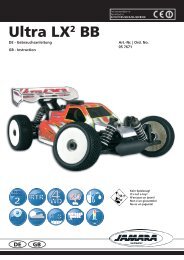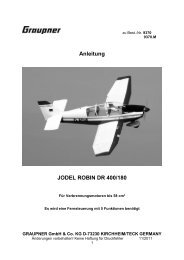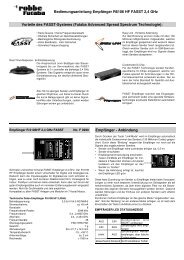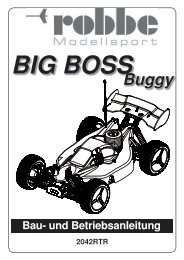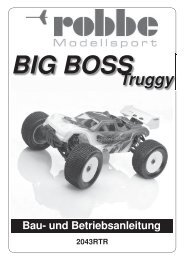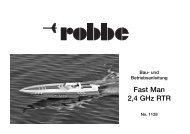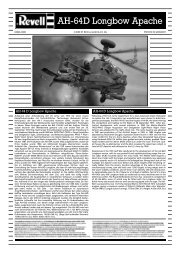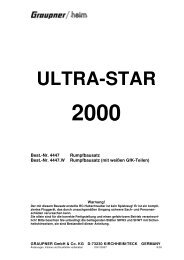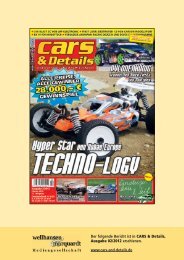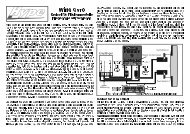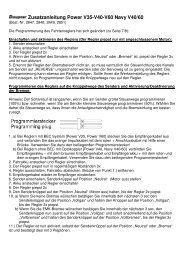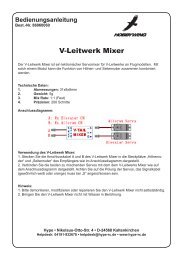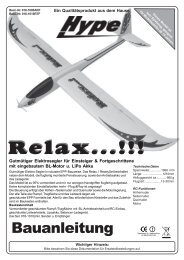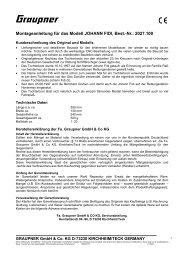GRAUPNER GmbH & Co. KG D-73230 KIRCHHEIM ... - CMC-Versand
GRAUPNER GmbH & Co. KG D-73230 KIRCHHEIM ... - CMC-Versand
GRAUPNER GmbH & Co. KG D-73230 KIRCHHEIM ... - CMC-Versand
Create successful ePaper yourself
Turn your PDF publications into a flip-book with our unique Google optimized e-Paper software.
Bauanleitung für das Modell SURPRISE F3A/3D, Best.-Nr. 9559<br />
<strong>GRAUPNER</strong> SURPRISE F3A/3D ist ein Kunstflugmodell für den Indoor- und<br />
Outdoorbereich, ausgelegt für sauberen, exakten Kunstflug und 3D-Flugtauglichkeit. Das<br />
Modell ist komplett aus 6-mm-Depron® aufgebaut, absolut torsionsfrei und sehr robust.<br />
Das Modell fliegt neutral und stabil. Die Tragflächenholme bestehen aus 10 x 0,5 mm<br />
Kohlefaserstäben, das Fahrwerk aus 12 x 2 mm Kohlefasermaterial. Der Motorträger besteht<br />
aus gelaserten Sperrholzteilen und ist auf die <strong>GRAUPNER</strong> COMPACT-Motorserie<br />
abgestimmt – es kann der Motorsturz und –seitenzug individuell eingestellt/abgestimmt<br />
werden. Die Depron®-/Sperrholz-/und Kohlefaserteile werden mit Styroporsekundenkleber/<br />
UHU por verklebt. Das Modell ist innerhalb kürzester Zeit fertig aufgebaut, die weißen<br />
Depron®-Teile können mit <strong>GRAUPNER</strong> Styropor-Sprühlack lackiert werden.<br />
<strong>GRAUPNER</strong> <strong>GmbH</strong> & <strong>Co</strong>. <strong>KG</strong> D-<strong>73230</strong> <strong>KIRCHHEIM</strong>/TECK GERMANY<br />
Änderungen vorbehalten! Keine Haftung für Druckfehler! 03/2006<br />
1
Technische Daten<br />
Spannweite 1050 mm<br />
Länge 950 mm<br />
Tragflächeninhalt ca. 20,73 dm²<br />
Höhenleitwerksinhalt ca. 4,8 dm²<br />
Gesamtflächenbelastung ca. 8 g/dm²<br />
Gewicht ab 280 g<br />
je nach Ausstattung<br />
RC-Funktionen<br />
Höhenruder<br />
Seitenruder<br />
Querruder<br />
Motor<br />
Empfohlene Servos<br />
Typ Best.-Nr. Anzahl Funktion<br />
C 271 5107 1 Höhenruder<br />
C 271 5107 1 Seitenruder<br />
C 271 5107 1 Querruder<br />
Es können auch die Servos C 2041 Best.-Nr. 5115.LOSE, C 261 Best.-Nr. 5125.LOSE oder<br />
C 271 Best.-Nr. 5107 verwendet werden.<br />
Empfohlener Empfänger<br />
XP 10 FM 35 Best.-Nr. 7020 oder R 600 light FM 35 Best.-Nr. 3549.10<br />
Empfohlene Fernsteuerungen<br />
<strong>GRAUPNER</strong>/JR-<strong>Co</strong>mputersysteme X-412 bis mc-24 im 35-MHz-Band, siehe ab Seite 136<br />
und <strong>GRAUPNER</strong> Hauptkatalog FS.<br />
Empfohlenes Zubehör<br />
Best.-Nr. Bezeichnung<br />
2873 Regler COMPACT CONTROL 10<br />
7700 Regler COMPACT 160 7,2V<br />
7706 Motor <strong>GRAUPNER</strong> COMPACT 260 7,2 V<br />
7707 Motor <strong>GRAUPNER</strong> COMPACT 260 8,4 V<br />
2945.18.10 SONIC-Luftschraube 18 x 10 cm<br />
oder<br />
2945.20.11 SONIC-Luftschraube 20 x 11 cm<br />
7708 <strong>GRAUPNER</strong> COMPACT 300 7,2 V<br />
2945.23.12 SONIC-Luftschraube 23 x 12 cm<br />
7690.3 Luftschraubenmitnehmer<br />
7605.3 Antriebsakku 3 LiPo 350<br />
7610.3 Antriebsakku 3 LiPo 650<br />
7615.3 Antriebsakku 3 LiPo 700<br />
7625.3 Antriebsakku 3 LiPo 1000<br />
928.... <strong>GRAUPNER</strong> Styroporlack<br />
5820 Styropor-Sekundenkleber<br />
953.150 Aktivatorspray<br />
98709 Glasfaserklebeband (für Ruderscharniere)<br />
959 UHU por<br />
<strong>GRAUPNER</strong> <strong>GmbH</strong> & <strong>Co</strong>. <strong>KG</strong> D-<strong>73230</strong> <strong>KIRCHHEIM</strong>/TECK GERMANY<br />
Änderungen vorbehalten! Keine Haftung für Druckfehler! 03/2006<br />
2
Wichtige Sicherheitshinweise<br />
Sie haben einen Bausatz erworben, aus dem – zusammen mit entsprechendem geeignetem<br />
Zubehör – ein funktionsfähiges RC-Modell fertiggestellt werden kann. Die Einhaltung der<br />
Montage- und Betriebsanleitung im Zusammenhang mit dem Modell sowie die Installation,<br />
der Betrieb, die Verwendung und Wartung der mit dem Modell zusammenhängenden<br />
Komponenten können von <strong>GRAUPNER</strong> nicht überwacht werden. Daher übernimmt<br />
<strong>GRAUPNER</strong> keinerlei Haftung für Verluste, Schäden oder Kosten, die sich aus dem<br />
fehlerhaften Betrieb, aus fehlerhaftem Verhalten bzw. in irgendeiner Weise mit dem<br />
vorgenannten zusammenhängend ergeben. Soweit vom Gesetzgeber nicht zwingend<br />
vorgeschrieben, ist die Verpflichtung der Firma <strong>GRAUPNER</strong> zur Leistung von<br />
Schadensersatz, aus welchem Grund auch immer ausgeschlossen (inkl. Personenschäden,<br />
Tod, Beschädigung von Gebäuden sowie auch Schäden durch Umsatz- oder<br />
Geschäftsverlust, durch Geschäftsunterbrechung oder andere indirekte oder direkte<br />
Folgeschäden), die von dem Einsatz des Modells herrühren.<br />
Die Gesamthaftung ist unter allen Umständen und in jedem Fall beschränkt auf den Betrag,<br />
den Sie tatsächlich für dieses Modell gezahlt haben.<br />
Die Inbetriebnahme und der Betrieb des Modells erfolgt einzig und allein auf Gefahr<br />
des Betreibers. Nur ein vorsichtiger und überlegter Umgang beim Betrieb schützt vor<br />
Personen- und Sachschäden.<br />
Nach der neuen Regelung des §103 Abs. 3 LuftVZO müssen alle Flugmodelle, egal ob<br />
Slowflyer, Parkflyer, Segelflugzeuge, Flugmodelle mit Antrieben jeglicher Art vor Aufnahme<br />
des Flugbetriebs versichert sein. Schließen Sie daher eine spezielle RC-Modell-<br />
Haftplichtversicherung ab. Fragen hierzu, werden Ihnen vom Fachhandel gerne beantwortet.<br />
Diese Sicherheitshinweise müssen unbedingt aufbewahrt werden und müssen bei einem<br />
Weiterverkauf des Modells an den Käufer weitergegeben werden.<br />
Garantiebedingungen<br />
Die Garantie besteht aus der kostenlosen Reparatur bzw. dem Umtausch von solchen<br />
Teilen, die während der Garantiezeit von 24 Monaten, ab dem Datum des Kaufes<br />
nachgewiesene Fabrikations- oder Materialfehler aufweisen. Weitergehende Ansprüche sind<br />
ausgeschlossen. Transport-, Verpackungs- und Fahrtkosten gehen zu Lasten des Käufers.<br />
Für Transportschäden wird keine Haftung übernommen. Bei der Einsendung an <strong>GRAUPNER</strong><br />
bzw. an die für das jeweilige Land zuständige Servicestelle sind eine sachdienliche<br />
Fehlerbeschreibung und die Rechnung mit dem Kaufdatum beizufügen. Die Garantie ist<br />
hinfällig, wenn der Ausfall des Teils oder des Modells von einem Unfall, unsachgemäßer<br />
Behandlung oder falscher Verwendung herrührt.<br />
Folgende Punkte müssen unbedingt beachtet werden:<br />
• Das Modell ist nicht für Kinder unter 14 Jahren geeignet. Nicht volljährige Jugendliche<br />
dürfen das Modell nur unter der Aufsicht eines Erziehungsberechtigten betreiben.<br />
• Jeder Modellflieger hat sich so zu verhalten, dass die öffentliche Sicherheit und<br />
Ordnung, insbesondere andere Personen und Sachen, sowie die Ordnung des<br />
Modellflugbetriebs nicht gefährdet oder gestört wird.<br />
• Der Betreiber muss im Besitz seiner vollen körperlichen und geistigen Fähigkeiten sein.<br />
Wie beim Autofahren, ist der Betrieb des Flugmodells unter Alkohol oder<br />
Drogeneinwirkung nicht erlaubt.<br />
• Fragen, die die Sicherheit beim Betrieb des RC-Flugmodells betreffen, werden Ihnen<br />
vom Fachhandel gerne beantwortet.<br />
• Fernsteuer-Flugmodelle sind sehr anspruchsvolle und gefährliche Gegenstände und<br />
erfordern vom Betreiber einen hohen Sachverstand, Können und<br />
Verantwortungsbewusstsein.<br />
<strong>GRAUPNER</strong> <strong>GmbH</strong> & <strong>Co</strong>. <strong>KG</strong> D-<strong>73230</strong> <strong>KIRCHHEIM</strong>/TECK GERMANY<br />
Änderungen vorbehalten! Keine Haftung für Druckfehler! 03/2006<br />
3
• Rechtlich gesehen, ist ein Flugmodell ein Luftfahrzeug und unterliegt entsprechenden<br />
Gesetzen, die unbedingt eingehalten werden müssen. Die Broschüre "Modellflugrecht,<br />
Paragrafen und mehr", Best.-Nr. 8034.01 stellt eine Zusammenfassung dieser Gesetze<br />
dar; sie kann auch beim Fachhandel eingesehen werden. Ferner müssen rechtliche<br />
Auflagen, die die Fernlenkanlage betreffen, beachtet werden. Entsprechende Hinweise<br />
finden Sie in der Bedienungsanleitung Ihrer Fernsteueranlage.<br />
• Ein RC-Flugmodell kann nur funktionsfähig sein und den Erwartungen entsprechen,<br />
wenn es im Sinne der Bauanleitung sorgfältigst gebaut wurde. Nur ein vorsichtiger und<br />
überlegter Umgang beim Betrieb schützt vor Personen- und Sachschäden. Niemand<br />
würde sich in ein Flugzeug setzen und - ohne vorausgegangene Schulung - versuchen,<br />
damit zu fliegen. Auch Modellfliegen will gelernt sein. Bitte wenden Sie sich dazu an<br />
erfahrene Modellflieger, an Vereine oder Modellflugschulen. Ferner sei auf den<br />
Fachhandel und die einschlägige Fachpresse verwiesen. Am besten als Club-Mitglied auf<br />
zugelassenem Modellflugplatz fliegen.<br />
• Beim erstmaligen Steuern eines Flugmodells ist es von Vorteil, wenn ein erfahrener<br />
Helfer bei der Überprüfung und den ersten Flügen zur Seite steht.<br />
• Es dürfen nur die dem Bausatz enthaltenen Teile, sowie die ausdrücklich von uns<br />
empfohlenen Graupner-Zubehör- und Ersatzteile verwendet werden. Wird auch nur eine<br />
Komponente der Antriebseinheit geändert, ist ein sicherer Betrieb nicht mehr<br />
gewährleistet und es erlischt jeglicher etwaiger Garantieanspruch.<br />
• Beachten Sie immer beim Einsatz und Laden der LiPo-Akkus die jeweiligen<br />
Sicherheitsvorschriften der Akkus. Diese sind den Akkus und dem Ladegerät beigelegt.<br />
• Das Flugmodell niemals in der Nähe von Hochspannungsleitungen, Industriegelände, in<br />
Wohngebieten, öffentlichen Straßen, Plätzen, Schulhöfen, Parks und Spielplätzen usw.<br />
fliegen lassen.<br />
• Informieren Sie alle Passanten und Zuschauer vor der Inbetriebnahme über alle<br />
möglichen Gefahren, die von Ihrem Modell ausgehen und ermahnen diese, sich in<br />
ausreichendem Schutzabstand, wenigstens 5 m hinter der Luftschraubenebene,<br />
aufzuhalten.<br />
• Stets mit dem notwendigen Sicherheitsabstand zu Personen oder Gegenständen fliegen;<br />
niemals Personen in niedriger Höhe überfliegen oder auf sie zufliegen!<br />
• Betreiben Sie Ihr Modell niemals in Naturschutz- und Landschaftsschutzgebieten.<br />
• Betrieben Sie es niemals bei widrigen Witterungsbedingungen, wie z.B. Regen,<br />
Gewitter, stärkerem Wind und Temperaturen unter – 5°C oder über +35°C<br />
• Kontrollieren Sie, bevor Sie das Modell betreiben, dieses auf eine sichere Funktion der<br />
Fernsteuerung sowie die Steckverbindungen auf sichere und feste Verbindung.<br />
• Verwenden Sie immer nur passende, verpolungssichere Steckverbindungen. Alle<br />
stromführenden Leitungen, Steckverbindungen, sowie die Antriebsbatterie, bei<br />
Selbstkonfektionierung, kurzschlusssicher isolieren. Kombinieren Sie niemals<br />
unterschiedliche, z. B. Blech- und Goldkontakte, da hier keine sichere Funktion<br />
gewährleistet ist.<br />
• Die Akkus müssen vor dem Betrieb geladen werden und die Reichweite der<br />
Fernsteuerung muss überprüft werden. Besonders der Senderakku muss vor jedem<br />
Einsatz geladen werden.<br />
• Prüfen Sie, ob der von Ihnen genutzte Kanal frei ist. Betreiben Sie Ihr Modell niemals,<br />
wenn Sie sich nicht sicher sind, ob der Kanal frei ist. Wenn andere Modellbauer in der<br />
Nähe sind, fragen Sie diese nach dem verwendeten Kanal.<br />
• Beachten Sie die Empfehlungen und Hinweise zu Ihrer Fernsteuerung und<br />
Zubehörteilen.<br />
• Arbeiten Sie an den Antriebsteilen nur bei abgezogener Motorstromversorgung.<br />
• Bei angeschlossenem Fahrakku dürfen Sie und andere Personen niemals in den<br />
Bereich des Propellers kommen, da durch diese eine erhebliche Verletzungsgefahr<br />
besteht.<br />
<strong>GRAUPNER</strong> <strong>GmbH</strong> & <strong>Co</strong>. <strong>KG</strong> D-<strong>73230</strong> <strong>KIRCHHEIM</strong>/TECK GERMANY<br />
Änderungen vorbehalten! Keine Haftung für Druckfehler! 03/2006<br />
4
• Die empfohlene Betriebsspannung nicht übersteigen. Eine höhere Spannung kann zum<br />
Überhitzen der Motoren bzw. des Fahrtreglers führen oder die elektrischen Leitungen<br />
können durchschmoren. Dadurch kann das Modell zerstört werden, da z.B. ein<br />
Schwelbrand entstehen kann.<br />
• Achten Sie auf Leichtläufigkeit aller Antriebskomponenten.<br />
• Achten Sie darauf, dass die Servos in ihrem Verfahrweg mechanisch nicht begrenzt<br />
werden.<br />
• Batterien und Akkus dürfen nicht kurzgeschlossen werden, sowie nicht direkt dem<br />
Wasser ausgesetzt werden.<br />
• Lassen Sie den Motor und den Fahrtregler nach jeder Fahrt abkühlen. Fassen Sie die<br />
möglicherweise heißen Teile nicht an.<br />
• Entnehmen Sie die Akkus beim Transport und Nichtgebrauch des Modells.<br />
• Setzen Sie das Modell nicht starker Luftfeuchtigkeit, Hitze, Kälte sowie Schmutz aus. Das<br />
Modell im Sommer nicht im heißen Auto liegen lassen.<br />
• Sichern Sie das Modell und RC-Komponenten beim Transport gegen Beschädigung<br />
sowie Verrutschen.<br />
• Bringen Sie bei einer evtl. Bergung des Modells sich nicht selbst sowie andere in<br />
Gefahr.<br />
Pflege und Wartung<br />
• Säubern Sie das Modell nach jedem Gebrauch.<br />
• Säubern Sie das Modell und die RC-Komponenten nur mit geeigneten Reinigungsmitteln.<br />
Informieren Sie sich hierzu bei Ihrem Fachhändler.<br />
Hinweise zum Bau des Modells<br />
• Vor dem Bau des Modells sollte man unbedingt die Anleitung bis zum Schluss studieren.<br />
Die Stückliste ist als Hilfsmittel zu benutzen. Anleitung und Stückliste sind weitgehend in<br />
der Reihenfolge des Zusammenbaus gehalten. Die Baustufenfotos sind zusätzlich zu<br />
benutzen, da auf diesen zusätzliche Informationen enthalten sind.<br />
• Achten Sie bei der Verwendung von Werkzeugen auf die möglichen Gefahren.<br />
• Um die ausgeschnittenen Depronteile plan bzw. an diese eine Fase anschleifen zu<br />
können, sollten Sie Schleifpapier auf ein glattes Stück Holz mit doppelseitigem<br />
Klebeband kleben. Als gut geeignet haben sich die Körnungen 120 und 240 erwiesen.<br />
• Die elektrischen Leitungen sauber, ohne Kreuzungen verlegen. Es darf keinesfalls die<br />
Plusleitung mit der Minusleitung elektrisch in Kontakt kommen können. Fixieren Sie alle<br />
Kabel zum Motor so, dass sie nicht in die drehenden Teile des Antriebs kommen können,<br />
z.B. mit Kabelbindern oder Klebeband.<br />
• Verlegen Sie die Empfangsantenne möglichst weit entfernt von den Fahrstrom leitenden<br />
Kabeln (mindestens 3 cm).<br />
• Schleifen Sie nicht die Oberfläche des Depron an, sondern nur die Klebestellen.<br />
• Achten Sie darauf, dass nur styroportaugliche Klebstoffe und Reinigungsmittel in Kontakt<br />
mit der Depronoberfläche kommen, da enthaltene Lösungsmittel die Oberfläche auflösen<br />
und zerstören können.<br />
• Empfohlene Klebstoffe bei einer Verbindung untereinander:<br />
Material – Material Geeignete Klebstoffe<br />
Kunststoff allgemein - Depron Styroporsekundenkleber/ UHU por<br />
Depron - Depron Styroporsekundenkleber/ UHU por<br />
Depron – Metall Styroporsekundenkleber/ UHU por<br />
Beachten Sie die Verarbeitungshinweise der Klebstoffe! Achten Sie auf besondere<br />
Hinweise in der Montageanleitung über den Einsatz bestimmter Klebstoffe! Bei<br />
Verwendung von Spiritus und anderen Lösungsmitteln als Reinigungsmittel, sind<br />
besondere Vorsichtsmaßnahmen nötig. Richten Sie sich nach den jeweiligen<br />
Verarbeitungsrichtlinien.<br />
<strong>GRAUPNER</strong> <strong>GmbH</strong> & <strong>Co</strong>. <strong>KG</strong> D-<strong>73230</strong> <strong>KIRCHHEIM</strong>/TECK GERMANY<br />
Änderungen vorbehalten! Keine Haftung für Druckfehler! 03/2006<br />
5
Vorwort<br />
Das Modell SURPRISE F3A/3D ist für den fortgeschrittenen Modellflieger, für hauptsächlich<br />
den Outdoor-Bereich bestimmt. Der Bausatz lässt sich von jedem Bastler ohne<br />
Spezialwerkzeug/großem Platzbedarf innerhalb allerkürzester Zeit zusammenbauen. Es ist<br />
empfehlenswert, sobald das Modell komplett rohbaufertig aufgebaut ist, d. h., die<br />
Antriebseinheit, RC-Komponenten und Anlenkungen, noch nicht montiert sind, die farbliche<br />
Gestaltung mit Graupner-Styropor-Sprühlack Best.-Nr. 928.... durchzuführen,<br />
selbstverständlich werden sämtliche Depron-Teile mit Schmirgelpapier der Körnung 220 an<br />
den Kanten/Umrissen bearbeitet.<br />
Sämtliche Ruderklappen werden mit Klebeband/Tesa-Film, wie abgebildet befestigt. Es ist<br />
aber aus Stabilitätsgründen ratsam, Glasfaserklebeband Best.-Nr. 98709 zu verwenden.<br />
Die Modell/Rumpfkonstruktion ist sehr torsionssteif aufgebaut, so dass auch bei Vollgas<br />
Geradeausflüge ein Verdrehen des Rumpfes, hauptsächlich im Bereich der Leitwerke,<br />
nahezu ausgeschlossen ist, was natürlich auch Gewichtszusatz mit sich bringt.<br />
Soll die SURPRISE vorwiegend im Indoor-Bereich eingesetzt werden, so kann natürlich das<br />
Modell auf Verstärkungen, auch auf das Fahrwerk u. U. verzichtet werden – in der<br />
bebilderten Bauanleitung wird ab Pos. 66 eine Möglichkeit gezeigt, wie wir ein Modell für den<br />
Indoor-Bereich modifiziert haben – textlich wird auf diese Modifikationen nicht eingegangen!<br />
Bauanleitung<br />
Achtung! Verwenden Sie an Klebstoffe ausschießlich solche, die für Depron/Styropor<br />
geeignet sind, gilt auch für Aktivator-Sprays, sonstige Beschleuniger, selbstverständlich auch<br />
Lackfarben. Wir empfehlen, Styropor-Sekundenkleber Best.-Nr. 5820, Aktivator-Spray Best.-<br />
Nr. 953.150, UHU por Best.-Nr. 959.<br />
- es ist empfehlenswert, das komplett rohbaufertige Modell, bevor die RC- und<br />
Antriebskomponenten eingebaut werden, die Kanten zu verschleifen, das Modell zu<br />
lackieren!<br />
Bild 1, 1a, 1b<br />
Querruder, Höhen- und Seitenruderklappe mit Schleiflatte, im Winkel von ca. 50°<br />
anschrägen.<br />
Bild 2, 2a<br />
Höhenruderklappe mit 5 Tesa-Streifen oder Gewebebandabschnitten wie abgebildet an<br />
Höhenleitwerk befestigen.<br />
Bild 2b, 2c<br />
Querruder ebenfalls mit 5 Tesa-Streifen oder Gewebebandabschnitten, wie abgebildet an<br />
Tragflächenhälften befestigen.<br />
Bild 3<br />
Es sollte ein Ausschlag der Höhen- und Querruderklappen von ca. 50° angestrebt werden –<br />
primär abhängig vom anschrägen der Ruderklappen.<br />
Bild 4<br />
Tragflächenhälften mit UHU por am Rumpf verkleben.<br />
Bild 5, 5a<br />
Tragflächen mit Tesa oder Gewebebandabschnitten wie abgebildet zusätzlich mit Rumpf<br />
verbinden/verstärken.<br />
Bild 6<br />
Rumpfoberteil, wie abgebildet auf Rumpf legen.<br />
<strong>GRAUPNER</strong> <strong>GmbH</strong> & <strong>Co</strong>. <strong>KG</strong> D-<strong>73230</strong> <strong>KIRCHHEIM</strong>/TECK GERMANY<br />
Änderungen vorbehalten! Keine Haftung für Druckfehler! 03/2006<br />
6
Bild 6a, 6b<br />
Durchbruch für Holm, wie abgebildet im Flügelbereich oben und unten markieren.<br />
Bild 7<br />
Kohlefaserstäbe (5) entsprechend Flügelspannweite ablängen und mit UHU por in Position<br />
wie angezeigt, ausgerichtet wie in Bild 7a, 7b und 7c verkleben.<br />
Bild 8, 8a<br />
Rumpfoberteil mit UHU por verkleben, mit Geo-Dreieck rechtwinklig ausrichten.<br />
Bild 9, 9a, 9b<br />
Rumpfverstärkungen (4) wie gezeigt ausrichten, mit Styropor-Sekundenkleber verkleben.<br />
Bild 10, 10a<br />
Rumpfunterteil mit UHU por verkleben/ausrichten mit Geo-Dreieck überprüfen.<br />
Bild 11<br />
Rumpfverstärkungen unten am Rumpf ausrichten und mit Sekundenkleber befestigen.<br />
Bild 12, 12a<br />
Seitenruder wie abgebildet mit Tesa-Streifen oder Gewebebandabschnitten befestigen.<br />
Bild 13, 13a, 13b, 13c<br />
Fahrwerksverstärkungen (4 Stück, aus Laserteil Motorplatte), mit Sekundenkleber wie<br />
abgebildet nach Maßangabe befestigen/verkleben.<br />
Bild 14, 14a<br />
Schlitze in Fahrwerksverstärkungen, am besten mit heißem Draht „ausbrennen“ – geht auch<br />
mit kleiner Rundfeile oder dementsprechendem Messer.<br />
Bild 15<br />
Fahrwerksbügel aus Kohlefaserstab (6) entsprechend ablängen/anfertigen.<br />
Bild 16<br />
Fahrwerksbügel, wie abgebildet, ungefähr in Position mit Bohrung ∅ 2,3 mm einbringen.<br />
Bild 16a<br />
Zeigt Aufbau/der Hauptfahrwerksbügel, ausgerichtet im Rumpf – durch Verschieben der<br />
Fahrwerksbügel (Kohlefaserstäbe) kann/muss das Modell/Tragflächen gegenüber einer<br />
geraden ebenen Unterlage parallel ausgerichtet werden.<br />
Bild 17, 17a<br />
Überstände der Fahrwerksbügel mit Schleiklotz oder Feile anpassen.<br />
Bild 18<br />
Ausgerichtete Fahrwerksbügel mit Styropor-Sekundenkleber befestigen.<br />
Bild 19<br />
Radverkleidungen mit UHU por wie abgebildet verkleben – darauf achten, dass je eine linke<br />
und rechte Radverkleidung hergestellt wird.<br />
<strong>GRAUPNER</strong> <strong>GmbH</strong> & <strong>Co</strong>. <strong>KG</strong> D-<strong>73230</strong> <strong>KIRCHHEIM</strong>/TECK GERMANY<br />
Änderungen vorbehalten! Keine Haftung für Druckfehler! 03/2006<br />
7
Bild 19a, 19b<br />
Mit Kohlefaserstab/Abschnitt ∅ 2 mm der auch als Radachse verwendet wird, ausgerichtetes<br />
Rad mit Radverkleidung/Radverkleidung durchstoßen.<br />
Bild 20, 20a<br />
Radachse/Kohlefaserstab ∅ 2 mm wie abgebildet, ausgerichtet und mit Sekundenkleber/<br />
Aktivatorspray verkleben.<br />
Bild 21, 22, 22a<br />
Radverkleidung auf Radachse aufstecken, Aussparung anzeichnen/ausschneiden.<br />
Bild 23<br />
Radverkleidung mit Styropor-Sekundenkleber verkleben.<br />
Bild 24, 24a<br />
Aus Depron-Abfallstück Radverkleidungsverstärkung anfertigen.<br />
Bild 25<br />
Radverkleidungsverstärkung verkleben.<br />
Bild 26, 27<br />
Radachse ablängen, Räder (15) mit Silikon-Gummitüllen (16) auf Kohlefaserachsen<br />
befestigen.<br />
Bild 28<br />
Spornfahrwerksbügel (17) mit Spornrad (18).<br />
Bild 28a<br />
Spornfahrwerksbügel wie abgebildet modifizieren und Spornrad durch abwinkeln des<br />
Drahtes befestigen.<br />
Bild 29<br />
Mit Rohr ∅ 1,5 mm in Seitenruder Aussparung einbringen.<br />
Bild 30<br />
Fertig konfektionierten Spornfahrwerksbügel mit Styropor-Sekundenkleber und<br />
Aktivatorspray verkleben.<br />
Bild 31<br />
Motorringhaltespant wie abgebildet, ausgerichtet auf Rumpfkopf mit Styropor-<br />
Sekundenkleber befestigen.<br />
Bild 32, 33, 33a<br />
Schematischer Aufbau der Motorhalteplatte (Sperrholz-Laserteile, Schrauben (13) und<br />
Gummitüllen (14)).<br />
Bild 34<br />
Sollte ein Elektromotor mit elastischer Propelleraufnahme verwendet werden, muss<br />
entsprechend eine Aussparung aus den Depron-Teilen im Rumpfkopf vorne, ungefähr wie<br />
abgebildet, ausgespart werden.<br />
Bild 35<br />
Motor befestigt auf Motorträger/Einheit komplett montiert. (Befestigungsmaterial liegt dem<br />
Motor bei).<br />
<strong>GRAUPNER</strong> <strong>GmbH</strong> & <strong>Co</strong>. <strong>KG</strong> D-<strong>73230</strong> <strong>KIRCHHEIM</strong>/TECK GERMANY<br />
Änderungen vorbehalten! Keine Haftung für Druckfehler! 03/2006<br />
8
Die Grundeinstellung des Motorsturz- und Seitenzugs, sollte anfangs parallel eingestellt<br />
werden, das bedeutet, 0° Motorsturz, 0° Seitenzug!<br />
Bild 36, 36a<br />
Mit Schrumpfschlauchabschnitt von (12) werden die Ruderhörner (Laserteile) mit den<br />
Kohlefaser-Rudergestängen, verbunden - Heißluftfön verwenden!<br />
Bild 37<br />
Zeigt, funktionsfähig, verbundenes, eingeschrumpftes Ruderhorn/Gestänge.<br />
Bild 38<br />
Querrudergestänge, Längenmaß entnehmen.<br />
Bild 39, 40<br />
Schematischer Gestängeaufbau / Längenmaße, des Höhen- und Seitenrudergestänges.<br />
Bild 41<br />
V-Ruderhörner, werden zur Führung des Höhen- und Seitenrudergestänges verwendet, wie<br />
abgebildet, mit ∅2,3 mm, aufbohren.<br />
Bild 42, 43, 44<br />
Mit Styroporsekundenkleber, werden die Ruderhörner/vorkonfektionierte Gestänge, wie in<br />
abgebildeten Positionen, befestigt.<br />
Bild 45<br />
Höhen- und Seitenruderservos werden, so wie abgebildet, in Position, mit<br />
Styroporsekundenkleber oder UHU por befestigt.<br />
Bild 46<br />
Ruderklappen generell, beim justieren der Gestängelänge, neutralisieren!<br />
Bild 47<br />
CFK-Rudergestänge, bei neutral eingestellten Servos und Ruderklappen, in<br />
Kunststoffgabelköpfe, mit Sekundenkleber, einkleben.<br />
Achtung! Bevor CFK-Gestänge in Gabelköpfe eingeklebt werden, je 1 aufgebohrtes V-<br />
Ruderhorn (11), auf CFK- Gestänge auffädeln!<br />
Bild 48, 48a, 49, 50<br />
Gestängeabstützung, (11,V-Ruderhorn), ausgerichtet, visuell und maßlich, wie bebildert, mit<br />
Styroporsekundenkleber, befestigen.<br />
Bild 51, 52<br />
Querruderservos, ausgerichtet, nach Tragflächenholm- und Klebestelle Rumpf/Flügel, mit<br />
Styroporsekundenkleber oder UHU por verkleben.<br />
Bild 53<br />
Servopositionen schematisch, gezeigt.<br />
Bild 54<br />
Position der Querruderanlenkungen, vorgefertigt nach Maß (Bild 38), ausgerichtet, verklebt<br />
an Querruderklappen, mit Styroporsekundenkleber.<br />
Bild 55, 56<br />
Mit Rundfeile, Durchbruch für Servokabel/Akkukabel schaffen.<br />
<strong>GRAUPNER</strong> <strong>GmbH</strong> & <strong>Co</strong>. <strong>KG</strong> D-<strong>73230</strong> <strong>KIRCHHEIM</strong>/TECK GERMANY<br />
Änderungen vorbehalten! Keine Haftung für Druckfehler! 03/2006<br />
9
Bild 57, 57a<br />
Befestigungslöcher für Regler/Empfänger mit kleinem Bohrer oder anderem spitzigen<br />
Gegenstand einbringen, wenn jene Komponenten mit Bindedraht Best.-Nr. 540.300, befestigt<br />
werden sollen.<br />
Bild 58<br />
Regler, befestigt mit Bindedraht, ansonst Motor/Reglerkombination ersichtlich.<br />
Bild 59<br />
Selbstklebenden Klettbandstreifen (19), zur Befestigung der LiPo-Flugakkus, wie abgebildet,<br />
in Schwerpunktposition befestigen.<br />
Bild 60<br />
Befestigter LiPo-Akku, ca. in Schwerpunktposition.<br />
Bild 61<br />
2 Depron- Lackierschablonen, für Kabinenhaubensilhouette (Laserteile).<br />
Bild 62<br />
Depron-Lackierschablonen, mit Wäscheklammern, an Rumpf befestigt, restliche Modell/<br />
Teile mit Haushaltsfolie/Papier abgedeckt.<br />
Bild 63, 63a, 63b, 64<br />
Kabinensilhouette, mit Graupner-Styroporlack, schichtweise, dünn und gleichmäßig<br />
lackieren.<br />
Bild 64a<br />
Sauber, fertig lackierte Kabinenhaube.<br />
Bild 65<br />
Zeigt nochmals, schematischer Einbau der RC-Komponenten.<br />
Soll das Modell ausschließlich für den Indoor-Bereich verwendet bzw. geflogen werden, kann<br />
sozusagen „in abgespeckter Version“ gebaut werden, das heißt, es wird das doch<br />
gewichtbringende Fahrwerk, nicht angebaut, auch kann im hinteren Rumpfbereich auf<br />
Rumpfverstärkungen (Teile 4), verzichtet werden, zudem nur 1 Querruderservo, eingebaut<br />
werden. Strukturell, ist das Modell in der von uns bebilderten, abgespeckten Version, mehr<br />
als ausreichend stabil edenfalls, für den Indoorbereich!<br />
Die Bilder, ab Position 66, zeigen Anregungen/Anlehnungen, wie wir unser Modell für reinen<br />
Indoorbereich umgebaut haben. Über die Bilder hinaus werden keine weiteren Angaben<br />
gemacht, anhand der Bemaßungsvorschläge, auch Abbildungen kann sicherlich jeder<br />
Modellbauer, unter Mitwirkung von Eigeninitiative, nachbauen, oder noch modifizieren/<br />
leichter bauen/Gewicht einsparen.<br />
Ist das Modell komplett, funktionsfähig, zusammengebaut, die Ruderausschläge ungefähr<br />
nach Angabe eingestellt, der Schwerpunkt durch richtiges positionieren des Akkus<br />
angestrebt, so steht dem Erstflug nichts im weg - das Modell ist in Bezug auf Schwerpunkt<br />
relativ unkritisch! Durch Verschieben des Schwerpunkts kann das Modell/Flugeigenschaften<br />
von gutmütig bis aggressiv eingestellt werden!,- tendenziell kopflastig eingestellt = gutmütig,<br />
schwanzlastig = aggressiv, - in Verbindung der in der Bauanleitung vorgegebenen<br />
Ruderausschläge!<br />
Das Graupner-Team wünscht Ihnen beim Bauen und Fliegen der Surprise F3A/3D, viel<br />
Erfolg und Spaß!<br />
<strong>GRAUPNER</strong> <strong>GmbH</strong> & <strong>Co</strong>. <strong>KG</strong> D-<strong>73230</strong> <strong>KIRCHHEIM</strong>/TECK GERMANY<br />
Änderungen vorbehalten! Keine Haftung für Druckfehler! 03/2006<br />
10
Ruderausschläge<br />
Höhenruder ± 30 mm Expo 35 %<br />
Seitenruder ± 45 mm Expo 45 %<br />
Querruder ± 40 mm Expo 45 %<br />
Die genannten Ausschlagsgrößen / Werte sind nur Anhaltswerte, und müssen vom Piloten<br />
individuell angepasst werden!<br />
Schwerpunkt 100 –120 mm, gemessen von der Nasenleisten / Flügelvorderkante<br />
bei 100 mm, reagiert das Modell zahm, bei 120 eher aggressiv!<br />
Motorsturz ca. 1°<br />
Seitenzug ca. 1,5<br />
Stückliste<br />
Depron-Laserteil 6 mm 1 Tragflächen/Querruder<br />
Depron-Laserteil 6 mm 2 Rumpf/Seitenruder –<br />
2 Lackierschablonen<br />
Depron-Laserteil 6 mm 3 Rumpf und Höhenruder<br />
Depron–Zuschnitt 3 mm 4 4 Depron-Abschnitte<br />
780x25x3 mm (Rumpfverstärkung)<br />
Kohlefaser-4-Kant 5 6x1x1000 mm (2 Stück)<br />
(Flügelholme)<br />
Kohlefaser-4-Kant 6 12x2x500 mm (Fahrwerke)<br />
Kohlefaserstäbe 7 ∅ 2x1000 (2 Stück)<br />
Sperrholz-Laserteil 8 Motorträger, Fahrwerksaufnahmen<br />
Sperrholz-Laserteil 9 Ruderhörner<br />
10 4 Kunststoffgabelköpfe<br />
11 2 V-Ruderhörner (Rudergestänge f. Rumpf)<br />
12 Schrumpfschlauch-Abschnitt ∅ 12 mm<br />
13 3 Zylinderschrauben M2x15<br />
(Motorbefestigung)<br />
14 6 Gummitüllen (Dämpfer am Motorspant)<br />
15 2 Moosgummiräder ∅ 30<br />
16 2 Silikongummitüllen (Befestigung Hauptfahrwerksräder<br />
auf Achse)<br />
17 Spornfahrwerksbügel<br />
18 Spornrad ∅ 15<br />
19 Klettband (zur Akkubefestigung)<br />
20 Dekorbogen<br />
<strong>GRAUPNER</strong> <strong>GmbH</strong> & <strong>Co</strong>. <strong>KG</strong> D-<strong>73230</strong> <strong>KIRCHHEIM</strong>/TECK GERMANY<br />
Änderungen vorbehalten! Keine Haftung für Druckfehler! 03/2006<br />
11
<strong>GRAUPNER</strong> <strong>GmbH</strong> & <strong>Co</strong>. <strong>KG</strong> D-<strong>73230</strong> <strong>KIRCHHEIM</strong>/TECK GERMANY<br />
Änderungen vorbehalten! Keine Haftung für Druckfehler! 03/2006<br />
12
<strong>GRAUPNER</strong> <strong>GmbH</strong> & <strong>Co</strong>. <strong>KG</strong> D-<strong>73230</strong> <strong>KIRCHHEIM</strong>/TECK GERMANY<br />
Änderungen vorbehalten! Keine Haftung für Druckfehler! 03/2006<br />
13
<strong>GRAUPNER</strong> <strong>GmbH</strong> & <strong>Co</strong>. <strong>KG</strong> D-<strong>73230</strong> <strong>KIRCHHEIM</strong>/TECK GERMANY<br />
Änderungen vorbehalten! Keine Haftung für Druckfehler! 03/2006<br />
14
<strong>GRAUPNER</strong> <strong>GmbH</strong> & <strong>Co</strong>. <strong>KG</strong> D-<strong>73230</strong> <strong>KIRCHHEIM</strong>/TECK GERMANY<br />
Änderungen vorbehalten! Keine Haftung für Druckfehler! 03/2006<br />
15
<strong>GRAUPNER</strong> <strong>GmbH</strong> & <strong>Co</strong>. <strong>KG</strong> D-<strong>73230</strong> <strong>KIRCHHEIM</strong>/TECK GERMANY<br />
Änderungen vorbehalten! Keine Haftung für Druckfehler! 03/2006<br />
16
<strong>GRAUPNER</strong> <strong>GmbH</strong> & <strong>Co</strong>. <strong>KG</strong> D-<strong>73230</strong> <strong>KIRCHHEIM</strong>/TECK GERMANY<br />
Änderungen vorbehalten! Keine Haftung für Druckfehler! 03/2006<br />
17
<strong>GRAUPNER</strong> <strong>GmbH</strong> & <strong>Co</strong>. <strong>KG</strong> D-<strong>73230</strong> <strong>KIRCHHEIM</strong>/TECK GERMANY<br />
Änderungen vorbehalten! Keine Haftung für Druckfehler! 03/2006<br />
18
<strong>GRAUPNER</strong> <strong>GmbH</strong> & <strong>Co</strong>. <strong>KG</strong> D-<strong>73230</strong> <strong>KIRCHHEIM</strong>/TECK GERMANY<br />
Änderungen vorbehalten! Keine Haftung für Druckfehler! 03/2006<br />
19
<strong>GRAUPNER</strong> <strong>GmbH</strong> & <strong>Co</strong>. <strong>KG</strong> D-<strong>73230</strong> <strong>KIRCHHEIM</strong>/TECK GERMANY<br />
Änderungen vorbehalten! Keine Haftung für Druckfehler! 03/2006<br />
20
<strong>GRAUPNER</strong> <strong>GmbH</strong> & <strong>Co</strong>. <strong>KG</strong> D-<strong>73230</strong> <strong>KIRCHHEIM</strong>/TECK GERMANY<br />
Änderungen vorbehalten! Keine Haftung für Druckfehler! 03/2006<br />
21
<strong>GRAUPNER</strong> <strong>GmbH</strong> & <strong>Co</strong>. <strong>KG</strong> D-<strong>73230</strong> <strong>KIRCHHEIM</strong>/TECK GERMANY<br />
Änderungen vorbehalten! Keine Haftung für Druckfehler! 03/2006<br />
22
<strong>GRAUPNER</strong> <strong>GmbH</strong> & <strong>Co</strong>. <strong>KG</strong> D-<strong>73230</strong> <strong>KIRCHHEIM</strong>/TECK GERMANY<br />
Änderungen vorbehalten! Keine Haftung für Druckfehler! 03/2006<br />
23
<strong>GRAUPNER</strong> <strong>GmbH</strong> & <strong>Co</strong>. <strong>KG</strong> D-<strong>73230</strong> <strong>KIRCHHEIM</strong>/TECK GERMANY<br />
Änderungen vorbehalten! Keine Haftung für Druckfehler! 03/2006<br />
24
<strong>GRAUPNER</strong> <strong>GmbH</strong> & <strong>Co</strong>. <strong>KG</strong> D-<strong>73230</strong> <strong>KIRCHHEIM</strong>/TECK GERMANY<br />
Änderungen vorbehalten! Keine Haftung für Druckfehler! 03/2006<br />
25
Building instructions for the SURPRISE F3A/3D, Order No. 9559<br />
zu Best.-Nr. 4661 MX<br />
The <strong>GRAUPNER</strong> SURPRISE F3A / 3D is an aerobatic model for flying indoors and<br />
outdoors, designed for smooth, accurate aerobatics and 3-D flying. The model is<br />
assembled entirely from 6 mm Depron®, making it totally torsionally rigid and very robust.<br />
It offers neutral flying characteristics combined with good stability. The wing spars consist<br />
of 10 x 0.5 mm carbon fibre strip, while the undercarriage is of 12 x 2 mm carbon fibre.<br />
The motor mount is assembled from laser-cut plywood parts, and is designed to accept the<br />
<strong>GRAUPNER</strong> COMPACT series of electric motors; downthrust and sidethrust can be<br />
adjusted individually. The Depron®, plywood and carbon fibre parts are glued together<br />
using foam cyano or UHU por adhesive, and the model can be assembled completely in a<br />
very short time. The white Depron® surfaces can be painted using <strong>GRAUPNER</strong> styrofoam<br />
spray paints.<br />
Specification<br />
Wingspan 1050 mm<br />
Length 950 mm<br />
Wing area approx. 20.73 dm²<br />
Tailplane area approx. 4.8 dm²<br />
Total surface area loading approx. 8 g/dm²<br />
Weight min. 280 g<br />
according to fittings<br />
RC functions<br />
Elevator<br />
Rudder<br />
Ailerons<br />
Throttle<br />
Recommended servos<br />
Type Order No. No. off Function<br />
C 271 5107 1 Elevator<br />
C 271 5107 1 Rudder<br />
C 271 5107 1 Ailerons<br />
The following servos are also suitable: C 2041, Order No. 5115.LOSE, C 261, Order No.<br />
5125.LOSE, and C 271, Order No. 5107.<br />
Recommended receivers<br />
XP 10 FM 35, Order No. 7020, or R 600 light FM 35, Order No. 3549.10<br />
Recommended radio control systems<br />
<strong>GRAUPNER</strong>/JR X-412 to mc-24 35 MHz band computer systems; see the main<br />
<strong>GRAUPNER</strong> FS catalogue.<br />
Recommended accessories<br />
Order No. Description<br />
2873 COMPACT CONTROL 10 speed controller<br />
7700 COMPACT 160 7.2 V motor<br />
<strong>GRAUPNER</strong> <strong>GmbH</strong> & <strong>Co</strong>. <strong>KG</strong> D-<strong>73230</strong> <strong>KIRCHHEIM</strong>/TECK GERMANY<br />
We reserve the right to introduce modifications. No liability for printing errors.<br />
1<br />
03/2006
7706 <strong>GRAUPNER</strong> COMPACT 260 7.2 V motor<br />
7707 <strong>GRAUPNER</strong> COMPACT 260 8.4 V motor<br />
2945.18.10 SONIC 18 x 10 cm propeller<br />
or<br />
2945.20.11 SONIC 20 x 11 cm propeller<br />
7708 <strong>GRAUPNER</strong> COMPACT 300 7.2 V motor<br />
2945.23.12 SONIC 23 x 12 cm propeller<br />
7690.3 Propeller driver<br />
7605.3 3 LiPo 350 flight battery<br />
7610.3 3 LiPo 650 flight battery<br />
7615.3 3 LiPo 700 flight battery<br />
7625.3 3 LiPo 1000 flight battery<br />
928.... <strong>GRAUPNER</strong> styrofoam paint<br />
5820 Styrofoam cyano-acrylate glue (“foam cyano”)<br />
953.150 Activator spray<br />
98709 Glass fibre tape (control surface hinges)<br />
959 UHU por adhesive<br />
Important Safety Notes<br />
You have acquired a kit which can be assembled into a fully working RC model when fitted<br />
out with suitable accessories. However, we as manufacturers have no control over the way<br />
you build and operate your RC model aircraft, nor how you install, operate and maintain<br />
the associated components, and for this reason we are obliged to deny all liability for loss,<br />
damage or costs which are incurred due to the incorrect use of our products or due to<br />
incompetent behaviour on the part of the user, or which are connected with such operation<br />
in any way. Unless otherwise prescribed by binding law, the obligation of the <strong>GRAUPNER</strong><br />
company to pay compensation, regardless of the legal argument employed, is excluded.<br />
This includes personal injury, death, damage to buildings, damages due to loss of<br />
business or turnover, interruption of business or other direct or indirect consequent<br />
damage whose root cause was the operation of the model.<br />
The total liability in all cases and under all circumstances is limited to the amount of money<br />
which you actually paid for the model.<br />
This model is built and flown at the sole and express responsibility of the operator.<br />
The only way to avoid injury to persons and damage to property is to handle and<br />
operate the model with the greatest care and consideration at all times.<br />
According to the new regulation of §103 Paragraph 3 of the LuftVZO (German Aviation<br />
Approvals Office), all model aircraft - whether slow-flyer, park-flyer, glider, or model aircraft<br />
propelled by any form of power plant - must be insured before the model is operated. If<br />
you are not sure about this, please ask at your local model shop where the staff will be<br />
glad to advise you.<br />
These safety notes must be kept in a safe place. If you ever dispose of the model, be sure<br />
to pass them on to the new owner.<br />
Guarantee terms<br />
The guarantee covers replacement of any parts which can be shown to exhibit<br />
manufacturing faults or material defects within the guarantee period of 24 months from the<br />
initial date of purchase. No other claims will be considered. <strong>Co</strong>st of transport, packing and<br />
freight are payable by the purchaser. We accept no liability for damage in transit. When<br />
you send the product to <strong>GRAUPNER</strong>, or to the approved Service Centre for your country,<br />
<strong>GRAUPNER</strong> <strong>GmbH</strong> & <strong>Co</strong>. <strong>KG</strong> D-<strong>73230</strong> <strong>KIRCHHEIM</strong>/TECK GERMANY<br />
We reserve the right to introduce modifications. No liability for printing errors. 03/2006<br />
2
you must include a clear and concise description of the fault together with the invoice<br />
showing the date of purchase. The guarantee is invalid if the component or model fails due<br />
to an accident, incompetent handling or incorrect usage.<br />
The following points are important and must be observed at all times:<br />
• This model is not suitable for young persons under 14 years of age. Young people<br />
under this age may safely operate the model, but only under the supervision of an<br />
adult or guardian.<br />
• All model flyers must behave in such a way that there is no danger of them<br />
endangering or adversely affecting public safety and order, and especially other<br />
people and property.<br />
• The operator of the model must be in full possession of his or her bodily and mental<br />
faculties. As with car driving, operating a model aircraft under the influence of alcohol<br />
or drugs is not permissible under any circumstances.<br />
• If you have any questions regarding the safe operation of your RC model aeroplane,<br />
please turn to your local model shop in the first instance, as the staff will be pleased to<br />
help you.<br />
• Radio-controlled model aircraft are extremely demanding and potentially dangerous<br />
objects, and require a high level of expertise, skill and responsibility from the operator.<br />
• In legal terms our models are classed as aircraft, and as such are subject to legal<br />
regulations and restrictions which must be observed at all times. Our brochure<br />
“Modellflugrecht, Paragrafen und mehr” (Model Aviation Law, Legal Requirements and<br />
more) is available under Order No. 8034.01, and contains a summary of all these<br />
rules. Your local model shop should have a copy which you can read. There are also<br />
Post Office regulations concerning your radio control system, and these must be<br />
observed. Refer to your RC system instructions for more details.<br />
• A radio-controlled model aircraft can only work properly and fulfil your expectations if it<br />
is built very carefully and in accordance with the building instructions. If you wish to<br />
avoid injuring people and damaging property it is essential to be careful and<br />
painstaking at all stages of building and operating your model. Nobody would climb<br />
into a full-size aircraft and try to fly it without undergoing training beforehand, and<br />
model flying is a skill which also needs to be learned. We suggest that you ask an<br />
experienced model flyer for help, or join a model club or flight training school. Your<br />
local model shop and the specialist magazines are excellent sources of information. If<br />
at all possible, it is always best to join a club and fly at the approved model flying site.<br />
• If you are flying a model aircraft for the first time we strongly recommend that you ask<br />
an experienced modeller to check the aeroplane first and be ready to help you during<br />
the first few flights.<br />
• Be sure to use only those parts included in the kit, together with other genuine<br />
Graupner accessories and replacement parts as recommended expressly by us. Even<br />
if you change a single component you can no longer be sure that the system will work<br />
reliably, and such changes also invalidate your guarantee.<br />
• Always read and observe the safety notes supplied with the batteries and the charger<br />
when using and charging LiPo batteries.<br />
• Never fly the model close to high-tension overhead cables, industrial areas, residential<br />
areas, public roads, squares, school playgrounds, parks and playing fields etc.<br />
• If there are passers-by or spectators at your flying site, make sure that they are aware<br />
of the dangers inherent in your activity before you start the motor, and insist that they<br />
keep a safe distance away - at least 5 m behind the propeller plane.<br />
<strong>GRAUPNER</strong> <strong>GmbH</strong> & <strong>Co</strong>. <strong>KG</strong> D-<strong>73230</strong> <strong>KIRCHHEIM</strong>/TECK GERMANY<br />
We reserve the right to introduce modifications. No liability for printing errors. 03/2006<br />
3
• Always keep a safe distance away from people and objects when flying; never fly low<br />
over people’s heads, and never fly directly towards them.<br />
• Never fly your model in protected sites, animal or plant sanctuaries or sites of special<br />
scientific interest (SSSIs).<br />
• Never fly the model in adverse conditions, e.g. rain, storm or strong wind, or<br />
temperatures below -5°C or above +35°C.<br />
• Before you fly the model check that the radio control system is working reliably, and<br />
that all connections are firmly seated.<br />
• Use only matching polarised electrical connectors. The flight battery, all cables and<br />
connectors must be insulated carefully to prevent short-circuits, especially if you make<br />
them up yourself. Never combine connectors with contacts of different materials, e.g.<br />
tin-plated and gold-plated, as the connections will not be reliable in the long-term.<br />
• The batteries must be given a full charge before the model is flown, and it is important<br />
to check the effective range of the radio control system. It is particularly important that<br />
the transmitter should be fully charged before each flying session.<br />
• Ensure that the frequency you intend to use is not already in use by other modellers.<br />
Never fly your model if you are not certain that your channel is free. If there are other<br />
modellers in the vicinity, ask them specifically which channels they are using.<br />
• Read and observe the instructions and recommendations supplied with your radio<br />
control system and accessories.<br />
• Always disconnect the power system from the flight battery before carrying out any<br />
work on these components.<br />
• When the drive battery is connected keep well clear of the area around the propeller,<br />
as this represents the greatest risk of accident and injury. Make sure any spectators<br />
do the same.<br />
• Do not be tempted to exceed the recommended operating voltage. Higher voltages<br />
may cause the motor to overheat, and the electrical cables may even melt. If this<br />
should happen, the model could easily be ruined or even catch fire.<br />
• Ensure that all the power system components are free-moving.<br />
• Check that your servos are not mechanically obstructed at any point in their full travel.<br />
• Dry cells and rechargeable batteries must never be short-circuited - fire hazard.<br />
• Allow the motor and speed controller to cool off after every flight. Take care not to<br />
touch the hot parts.<br />
• Remove the rechargeable battery if the model is to be transported, or will not be used<br />
for a long period.<br />
• Do not subject the model to high levels of humidity, heat, cold or dirt, and never leave<br />
it in a hot car in the Summer.<br />
• Secure the model and your RC equipment carefully when transporting them. They may<br />
be seriously damaged if they are free to slide about,.<br />
• If you have to recover the model after an out-landing, take care not to risk your own<br />
life or that of others.<br />
Care and maintenance<br />
• Clean the model carefully after every session.<br />
• Clean the model and transmitter using suitable cleaning agents only. Ask your local<br />
model shop if you are not sure.<br />
Notes on building the model<br />
• Before you start construction it is essential to read right through these instructions,<br />
using the Parts List constantly as a reference. In general terms the Building<br />
<strong>GRAUPNER</strong> <strong>GmbH</strong> & <strong>Co</strong>. <strong>KG</strong> D-<strong>73230</strong> <strong>KIRCHHEIM</strong>/TECK GERMANY<br />
We reserve the right to introduce modifications. No liability for printing errors. 03/2006<br />
4
Instructions and the Parts List reflect the sequence of assembly. Be sure to study the<br />
stage photos when building, as they are a valuable source of additional information.<br />
• Bear in mind the possible hazards involved in the use of tools.<br />
• You will need a sanding block for sanding the edges of the pre-cut Depron parts, and<br />
for chamfering the edges of hinged panels. Make this by sticking abrasive paper to a<br />
flat wooden block using double-sided adhesive tape. 120-grit and 240-grit abrasives<br />
have proved ideal.<br />
• Deploy all cables neatly, wherever possible without crossing them over. It is of<br />
fundamental importance never to allow a positive wire to make electrical contact with a<br />
negative wire. Deploy all motor cables in such a way that there is no chance of them<br />
contacting any rotating parts of the power system. Use cable ties or adhesive tape for<br />
this.<br />
• Deploy the receiver aerial as far from all high-current wires as possible (at least 3 cm).<br />
• Don’t sand the surface of the Depron parts; only the joint surfaces should be sanded<br />
before gluing.<br />
• Please ensure that the only materials to make contact with the Depron surfaces are<br />
foam-compatible adhesives and cleaning agents, as other solvents may dissolve and<br />
destroy the surface.<br />
• Recommended adhesives for gluing various materials:<br />
Material - material Suitable adhesives<br />
Plastic generally - Depron Foam cyano / UHU por<br />
Depron - Depron Foam cyano / UHU por<br />
Depron - metal Foam cyano / UHU por<br />
Read and observe the instructions supplied with all adhesives! The building<br />
instructions inform you when to use particular glues. If you wish to use white spirit<br />
or other solvent as a cleaning agent, note that special safety measures are required.<br />
Read the instructions supplied with these materials.<br />
Introduction<br />
The SURPRISE F3A/3D is designed for the advanced modeller, and is intended primarily<br />
for flying outdoors. The kit can be assembled extremely quickly by anyone, as it requires<br />
no special tools and little space. We recommend that you apply the colour finish as soon<br />
as the basic airframe is complete, i.e. before the power system, RC components and<br />
linkages are installed. Use Graupner Styrofoam spray paints (Order No. 928…) for this.<br />
Naturally all Depron parts should be sanded smooth at the edges and outlines using 220grit<br />
abrasive paper before the paint is applied.<br />
All control surfaces can be attached using ordinary adhesive tape. However, we<br />
recommend glass fibre tape, Order No. 98709, as shown in the illustrations, as it is more<br />
durable.<br />
The design of the fuselage and the model generally provides good torsional rigidity, with<br />
the result that there is virtually no tendency for the fuselage to twist even when flying<br />
straight and level at full-throttle. However, this stiffness does involve additional weight,<br />
especially in the tail area.<br />
If you intend to fly the SURPRISE mainly indoors, you can save weight by omitting various<br />
reinforcements, as well as the undercarriage. In these building instructions the illustrations<br />
from No. 66 on show a model we have modified for indoor flying, although the text does<br />
not cover these changes in detail.<br />
<strong>GRAUPNER</strong> <strong>GmbH</strong> & <strong>Co</strong>. <strong>KG</strong> D-<strong>73230</strong> <strong>KIRCHHEIM</strong>/TECK GERMANY<br />
We reserve the right to introduce modifications. No liability for printing errors. 03/2006<br />
5
Building instructions<br />
Caution: use only adhesives which are suitable for Depron / Styrofoam; this applies to<br />
activator sprays, other accelerators, and - of course - colour paints. We recommend the<br />
following: Styrofoam cyano-acrylate (“foam cyano”), Order No. 5820, activator spray,<br />
Order No. 953.150 and UHU por, Order No. 959.<br />
Figs. 1, 1a, 1b<br />
Sand the leading edge of the ailerons, elevator and rudder at an angle of 50° using a long<br />
sanding block as shown.<br />
Figs. 2, 2a<br />
Attach the elevator to the tailplane using five strips of adhesive tape or glass fibre tape.<br />
Figs. 2b, 2c<br />
Attach the ailerons to the wing panels, also using five strips of adhesive tape or glass fibre<br />
tape, as illustrated for the elevator.<br />
Fig. 3<br />
Aim at obtaining around 50° of travel for the elevator and ailerons; the limiting factor is<br />
generally the chamfer angle.<br />
Fig. 4<br />
Glue the wing panels to the fuselage using UHU por.<br />
Figs. 5, 5a<br />
Apply pieces of adhesive tape or glass fibre tape over the wing / fuselage joints to<br />
reinforce them, as shown in the pictures.<br />
Fig. 6<br />
Place the upper fuselage section on the fuselage.<br />
Figs. 6a, 6b<br />
Mark the recess top and bottom where the wing spar passes through the fuselage, as<br />
shown.<br />
Fig. 7<br />
Cut the carbon fibre strips (5) to the same length as the wingspan, and glue them to the<br />
wing as indicated. Align the strips as shown in Figs. 7a, 7b and 7c.<br />
Figs. 8, 8a<br />
Glue the upper fuselage section in place using UHU por, using a setsquare to position it at<br />
right-angles.<br />
Figs. 9, 9a, 9b<br />
Position the fuselage reinforcements (4) as shown, and glue them to the structure using<br />
foam cyano.<br />
Figs. 10, 10a<br />
<strong>GRAUPNER</strong> <strong>GmbH</strong> & <strong>Co</strong>. <strong>KG</strong> D-<strong>73230</strong> <strong>KIRCHHEIM</strong>/TECK GERMANY<br />
We reserve the right to introduce modifications. No liability for printing errors. 03/2006<br />
6
Glue the bottom fuselage section to the structure using UHU por, again using a setsquare<br />
to position it at right-angles.<br />
Fig. 11<br />
Hold the bottom fuselage reinforcements on the fuselage and fix them in place with foam<br />
cyano.<br />
Figs. 12, 12a<br />
Attach the rudder to the fin using strips of adhesive tape or glass fibre tape, as shown.<br />
Figs. 13, 13a, 13b, 13c<br />
Attach the undercarriage supports (four off, from the laser-cut plywood motor plate sheet)<br />
to the fuselage in the positions shown; use foam cyano, and keep to the stated<br />
dimensions.<br />
Figs. 14, 14a<br />
“Burn out” the foam inside the slots in the undercarriage supports using a hot wire;<br />
alternatively you could use a small round file or a sharp balsa knife.<br />
Fig. 15<br />
Cut the undercarriage legs to length from the carbon fibre strip (6) supplied.<br />
Fig. 16<br />
Drill a 2.3 mm Ø hole in each undercarriage leg as shown.<br />
Fig. 16a<br />
This picture shows the position of the main undercarriage legs in the fuselage; adjust the<br />
position of the carbon fibre legs until the model (wing) is parallel to the base surface.<br />
Figs. 17, 17a<br />
Mark the projecting ends of the undercarriage legs and file or sand them back to the<br />
marked lines.<br />
Fig. 18<br />
Carefully position the undercarriage legs again and glue them in place using foam cyano.<br />
Fig. 19<br />
Glue the wheel spats together using UHU por, taking care to produce one left-hand and<br />
one right-hand spat.<br />
Figs. 19a, 19b<br />
Place the wheels in position on the spats, and push an offcut of 2 mm Ø carbon fibre rod<br />
(wheel axle) through the wheels and the spats.<br />
Figs. 20, 20a<br />
Position the wheel axles (2 mm Ø carbon fibre rod) as shown, and glue them to the<br />
undercarriage lugs using foam cyano and activator spray.<br />
Figs. 21, 22, 22a<br />
Fit the wheel spats on the wheel axles, mark the position of the notch on the spats and cut<br />
them out as shown.<br />
<strong>GRAUPNER</strong> <strong>GmbH</strong> & <strong>Co</strong>. <strong>KG</strong> D-<strong>73230</strong> <strong>KIRCHHEIM</strong>/TECK GERMANY<br />
We reserve the right to introduce modifications. No liability for printing errors. 03/2006<br />
7
Fig. 23<br />
Glue the wheel spats to the undercarriage legs using foam cyano.<br />
Figs. 24, 24a<br />
Cut the wheel spat gussets from scrap Depron as shown.<br />
Fig. 25<br />
Glue the wheel spat gussets in place.<br />
Figs. 26, 27<br />
Cut the carbon fibre wheel axles to length, fit the wheels (15) on the axles and secure<br />
them with the silicone rubber grommets (16) supplied.<br />
Fig. 28<br />
The tailwheel unit (17) and tailwheel (18).<br />
Fig. 28a<br />
Modify the tailwheel unit as shown, fit the wheel and bend the end of the axle over to<br />
secure it.<br />
Fig. 29<br />
Drill a hole in the rudder using a piece of 1.5 mm Ø metal tube as a drill.<br />
Fig. 30<br />
Glue the prepared tailwheel unit in the rudder using foam cyano and activator spray.<br />
Fig. 31<br />
Glue the annular motor bulkhead to the front face of the fuselage using foam cyano.<br />
Figs. 32, 33, 33a<br />
The motor mounting plate components laid out: laser-cut plywood parts, screws (13) and<br />
rubber grommets (14).<br />
Fig. 34<br />
If you wish to use an electric motor with a flexible prop-saver, you will need to cut away the<br />
front of the fuselage approximately as shown.<br />
Fig. 35<br />
The motor fitted to the mount assembly, using the fixings supplied with the motor.<br />
The motor thrustline should initially be set “parallel”, i.e. 0° downthrust, 0° sidethrust.<br />
Figs. 36, 36a<br />
The laser-cut control surface horns are connected to the carbon fibre pushrods using<br />
pieces of heat-shrink sleeve (12); shrink them in place using a heat-gun.<br />
Fig. 37<br />
This picture shows a completed horn / pushrod assembly connected with a heat-shrink<br />
sleeve, ready to use.<br />
Fig. 38<br />
<strong>GRAUPNER</strong> <strong>GmbH</strong> & <strong>Co</strong>. <strong>KG</strong> D-<strong>73230</strong> <strong>KIRCHHEIM</strong>/TECK GERMANY<br />
We reserve the right to introduce modifications. No liability for printing errors. 03/2006<br />
8
The aileron pushrods; cut them to the stated length.<br />
Figs. 39, 40<br />
Pushrod assembly showing the correct length of the elevator and rudder pushrods.<br />
Fig. 41<br />
The V-horns are used as guides for the elevator and rudder pushrods. Drill a 2.3 mm Ø<br />
hole in each one.<br />
Figs. 42, 43, 44<br />
Attach the horn / pushrod assemblies to the control surfaces in the positions shown.<br />
Fig. 45<br />
Fix the elevator and rudder servos in position using foam cyano or UHU por.<br />
Fig. 46<br />
Clamp the control surfaces in the neutral position as shown.<br />
Fig. 47<br />
With the control surfaces and associated servos at neutral, glue the carbon fibre pushrods<br />
in the clevises with a drop of cyano.<br />
Caution: remember to slip one bored V-horn (11) on each carbon fibre pushrod before<br />
gluing the pushrods in the clevises.<br />
Figs. 48, 48a, 49, 50<br />
Position the V-horns (11) in the position shown in the pictures, check that they line up<br />
correctly with the pushrods, and fix them in place with a drop of foam cyano.<br />
Figs. 51, 52<br />
Position the aileron servos as shown relative to the wing spar and the fuselage / wing joint,<br />
and glue them in place using foam cyano or UHU por.<br />
Fig. 53<br />
The overall position of the servos.<br />
Fig. 54<br />
The aileron linkages prepared to the dimensions stated in Fig. 38, and glued to the<br />
ailerons using foam cyano.<br />
Figs. 55, 56<br />
Cut the holes through the fuselage for the servo leads / battery lead using a round file.<br />
Figs. 57, 57a<br />
If you intend to attach the speed controller and receiver using soft binding wire (Order No.<br />
540.300), cut the holes using a small drill or similar pointed tool.<br />
Fig. 58<br />
The speed controller held in place with binding wire; the motor / speed controller<br />
combination is also shown.<br />
Fig. 59<br />
<strong>GRAUPNER</strong> <strong>GmbH</strong> & <strong>Co</strong>. <strong>KG</strong> D-<strong>73230</strong> <strong>KIRCHHEIM</strong>/TECK GERMANY<br />
We reserve the right to introduce modifications. No liability for printing errors. 03/2006<br />
9
Attach the strip of self-adhesive Velcro (hook-and-loop) tape (19) for the LiPo flight battery<br />
to the fuselage at the Centre of Gravity position.<br />
Fig. 60<br />
The LiPo battery mounted approximately at the CG.<br />
Fig. 61<br />
The two laser-cut Depron painting templates for the canopy silhouette.<br />
Fig. 62<br />
Fix the Depron templates to the fuselage using clothes pegs, and mask out the rest of the<br />
model using scrap paper.<br />
Figs. 63, 63a, 63b, 64<br />
Spray the canopy silhouette using Graupner styrofoam paint. Apply several thin coats until<br />
the paint covers properly.<br />
Fig. 64a<br />
A neatly finished painted canopy.<br />
Fig. 65<br />
This picture shows the complete RC system installation.<br />
If you intend to fly indoors exclusively, it is possible to build a specially lightened version of<br />
the model. This means omitting the undercarriage (saving weight), and the rear fuselage<br />
reinforcements (parts 4). You can also use only one aileron servo. Structurally the model is<br />
more than strong enough for indoor flying in the lightened version shown here.<br />
The pictures starting at No. 66 show ideas for modifications which we have used to<br />
convert our model purely for indoor flying. We do not provide detailed information in<br />
addition to the pictures, but any modeller should be able to emulate these ideas using his<br />
own initiative and the suggested dimensions. You may even be able to make further<br />
modifications and save more weight.<br />
With the model complete and assembled ready for flying, adjust the control surface travels<br />
to the stated values and set the correct CG by adjusting the position of the flight pack.<br />
Your model is now ready for its first flight. It is not particularly critical regarding the CG<br />
position, and you can adjust the aeroplane’s flying characteristics from docile to<br />
responsive by adjusting the Centre of Gravity: slightly nose-heavy makes it docile, while<br />
slightly tail-heavy makes it much more responsive; this assumes that you have set the<br />
control surface travels as stated in these building instructions.<br />
All of us in the Graupner Team wish you many hours of pleasure building and flying the<br />
Surprise F3A/3D.<br />
<strong>Co</strong>ntrol surface travels<br />
Elevator +/- 30 mm Expo 35%<br />
Rudder +/- 45 mm Expo 45%<br />
Ailerons +/- 40 mm Expo 45%<br />
The stated travels are only a guideline; you may well wish to change them after test-flying<br />
your model.<br />
<strong>GRAUPNER</strong> <strong>GmbH</strong> & <strong>Co</strong>. <strong>KG</strong> D-<strong>73230</strong> <strong>KIRCHHEIM</strong>/TECK GERMANY<br />
We reserve the right to introduce modifications. No liability for printing errors. 03/2006<br />
10
Centre of Gravity 100 - 120 mm, measured aft from the root leading edge. At 100 mm<br />
the model is docile; at 120 mm it is much more responsive.<br />
Motor downthrust approx. 1°<br />
Motor sidethrust approx. 1.5°<br />
Parts List<br />
Laser-cut 6 mm Depron 1 Wings / ailerons<br />
Laser-cut 6 mm Depron 2 Fuselage / rudder -<br />
2 painting templates<br />
Laser-cut 6 mm Depron 3 Fuselage and tailplane<br />
3 mm Depron panel 4 4 Depron pieces<br />
780 x 25 x 3 mm (fuselage reinforcements)<br />
Flat carbon fibre strip 5 6 x 1 x 1000 mm (2 off)<br />
(wing spars)<br />
Flat carbon fibre strip 6 12 x 2 x 500 (undercarriage legs)<br />
Carbon fibre rod 7 2 Ø x 1000 (2 off)<br />
Laser-cut plywood 8 Motor mount, undercarriage supports<br />
Laser-cut plywood 9 <strong>Co</strong>ntrol surface horns<br />
10 4 plastic clevises<br />
11 2 V-horns (fuselage pushrod guides)<br />
12 Heat-shrink sleeve, 12 mm Ø<br />
13 3 cheesehead screws, M2 x 15<br />
(motor mounting)<br />
14 6 rubber grommets (motor bulkhead dampers)<br />
15 2 foam rubber wheels, 30 Ø<br />
16 2 silicone rubber grommets<br />
(for mounting main wheels on axles)<br />
17 Tailwheel unit<br />
18 Tailwheel, 15 Ø<br />
19 Velcro tape (battery retention)<br />
20 Decal sheet<br />
[ Abbildungstexte ]<br />
(16) Drill diameter 2 mm<br />
(29) Drill diameter approx. 1.5 mm<br />
(38) Aileron pushrod 75 mm<br />
(40) Rudder pushrod 490 mm<br />
Elevator pushrod 470 mm<br />
(49) approx. 210 mm<br />
<strong>GRAUPNER</strong> <strong>GmbH</strong> & <strong>Co</strong>. <strong>KG</strong> D-<strong>73230</strong> <strong>KIRCHHEIM</strong>/TECK GERMANY<br />
We reserve the right to introduce modifications. No liability for printing errors. 03/2006<br />
11
Graupner<br />
Instructions de montage pour le modèle SURPRISE F3A/3D, Réf. N°9559<br />
Le SURPRISE F3A/3D <strong>GRAUPNER</strong> est un modèle de voltige pour le vol d’intérieur et d’extérieur<br />
conçu pour l’exécution de figures de voltige propres et exactes et pour l’aptitude au vol 3D. Le modèle<br />
est entièrement construit en Depron® de 6mm, absolument résistant à la torsion et très robuste.<br />
Ce modèle a des caractéristiques de vol neutres et stables. Le longeron de l’aile est constitué d’un<br />
profilé en fibre de carbone de 10 x 0,5 mm et le train d’atterrissage est en matière de fibre de carbone<br />
de 12 x 2mm. Le bâti-moteur est composé de pièces en contre-plaqué découpées au Laser et adapté<br />
pour la série des moteurs <strong>GRAUPNER</strong> COMPACT ; les angles piqueur et d’anti-couple pourront être<br />
individuellement adaptés et réglés. Les pièces en Depron®, en contre-plaqué et en fibre de carbone<br />
pourront être collées avec de la colle-seconde pour Styropor ou de la UHU por. Le modèle peut être<br />
assemblé en un temps très court, les pièces en Depron® blanc pourront être peintes avec de la<br />
peinture en bombe pour Styropor <strong>GRAUPNER</strong>.<br />
Caractéristiques techniques<br />
Envergure, env. 1050mm<br />
Longueur, env. 950mm<br />
Surface de l’aile, env. 20,73 dm²<br />
Surface du stabilisateur, env. 4,8 dm²<br />
Charge alaire, env. 8 g/dm²<br />
Poids à partir de 280 g.<br />
(selon équipement)<br />
Fonctions R/C<br />
Profondeur<br />
Direction<br />
Ailerons<br />
Régulation du moteur<br />
Servos conseillés<br />
Type Réf. N° Qté Fonction<br />
C 1041 5116 1 Profondeur<br />
C 1041 5116 1 Direction<br />
C 1041 5116 2 Ailerons<br />
Des servos C 2041, Réf. N°5115.LOSE, C 261, Réf. N°5115.LOSE, ou C 271, Réf. N°5107<br />
pourront aussi être utilisés.<br />
Récepteurs conseillés<br />
XP 10 FM 41, Réf. N° 7020.41ou R 600 light FM 41 Réf. N°3549.41.<br />
Ensemble R/C conseillé<br />
Système à micro-ordinateur <strong>GRAUPNER</strong>/JR X-412 à mc-24 dans la bande des 41 MHz,<br />
voir à partir de la page 136 et dans le catalogue général <strong>GRAUPNER</strong> FS.<br />
Accessoires conseillés<br />
Réf. N° Désignation<br />
2873 Régulateur COMPACT CONTROL 10<br />
7700 Régulateur COMPACT 160 7,2 V<br />
7706 Moteur <strong>GRAUPNER</strong> COMPACT 260 7,2 V<br />
7707 Moteur <strong>GRAUPNER</strong> COMPACT 260 8,4 V<br />
2945.18.10 Hélice SONIC 18 x 10 cm<br />
ou<br />
2945.20.11 Hélice SONIC 20 x 11 cm<br />
7708 <strong>GRAUPNER</strong> COMPACT 300 7,2 V<br />
2945.23.12 Hélice SONIC 23 x 12 cm<br />
7690.3 Moyeu d’hélice
7605.3 Accu de propulsion 3 LiPo 350<br />
7610.3 Accu de propulsion 3 LiPo 650<br />
7615.3 Accu de propulsion 3 LiPo 700<br />
7625.3 Accu de propulsion 3 LiPo 1000<br />
928.... Peinture pour Styropor <strong>GRAUPNER</strong><br />
5820 <strong>Co</strong>lle-seconde pour Styropor<br />
953.150 Activateur en bombe<br />
98709 Ruban adhésif en fibre de verre<br />
959 UHU por<br />
<strong>Co</strong>nseils de sécurité importants<br />
Vous avez fait l'acquisition d'une boite de construction avec les accessoires correspondants qui vont<br />
vous permettre la réalisation d'un modèle radiocommandé. Le respect des instructions de montage et<br />
d'utilisation relatives au modèle ainsi que l'installation, l'utilisation et l'entretien des éléments de son<br />
équipement ne peuvent pas être surveillés par la Firme <strong>GRAUPNER</strong>. C'est pourquoi nous déclinons<br />
toute responsabilité concernent les pertes, les dommages ou les coûts résultants d'une mauvaise<br />
utilisation ou d'un fonctionnement défectueux. Tant qu'elle n'y a pas été contrainte par le législateur, la<br />
responsabilité de la Firme <strong>GRAUPNER</strong> n'est aucunement engagée pour les dédommagements<br />
(incluant les dégâts personnels, les cas de décès, la détérioration de bâtiments ainsi que le<br />
remboursement des pertes commerciales dues à une interruption d'activité ou à la suite d'autres<br />
conséquences directes ou indirectes) provenant de l'utilisation du modèle.<br />
L'ensemble de sa responsabilité est en toutes circonstances et dans chaque cas strictement limitée au<br />
montant que vous avez réellement payé pour ce modèle.<br />
L'utilisation du modèle se fait uniquement aux risques et périls de son utilisateur. Seule une<br />
utilisation prudente et responsable évitera de causer des dégâts personnels et matériels.<br />
Les modèles motorisés de tous genres doivent être assurés avant leur utilisation. <strong>Co</strong>ntractez pour cela<br />
une assurance spéciale pour les modèles radiocommandés. Demandez à votre revendeur qui vous<br />
renseignera volontiers.<br />
Ces conseils de sécurité devront être soigneusement conservés et remis à l’acheteur en cas de<br />
revente du modèle.<br />
<strong>Co</strong>nditions de garantie:<br />
La garantie comprend la réparation gratuite ou l'échange des pièces présentant un défaut de<br />
fabrication ou de matière pendant une durée de 24 mois, à compter de la date de l'achat. Toutes<br />
autres réclamations sont exclues. Les frais de transport et d'emballage sont à la charge de l'acheteur.<br />
Nous déclinons toute responsabilité pour les détériorations survenues au cours du transport. Le retour<br />
au Service-après-Vente <strong>GRAUPNER</strong>, ou du Pays concerné doit être accompagné d'une description<br />
du défaut constaté et de la facture correspondante avec la date de l'achat. Le bénéfice de la garantie<br />
sera perdu lorsque le défaut de la pièce ou du modèle sera dû à un accident, à une manipulation<br />
incorrecte ou à une mauvaise utilisation<br />
Les points suivants devront être impérativement observés :<br />
• Ce modèle ne convient pas aux enfants en dessous de 14 ans. Les jeunes gens insuffisamment<br />
âgés devront utiliser le modèle uniquement sous la surveillance d’un adulte compétent.<br />
• Chaque modéliste doit se comporter de façon à ce que l'ordre et la sécurité publiques, vis-à-vis<br />
des autres personnes et des biens, ainsi que l'activité des autres modélistes ne soient pas mis en<br />
danger, ni perturbés.<br />
• L'utilisateur doit être en pleine possession de ses facultés physiques et mentales. <strong>Co</strong>mme pour la<br />
conduite des automobiles, le pilotage des modèles volants sous l'effet de l'alcool ou de la drogue<br />
n'est pas autorisé.<br />
• Demandez à votre revendeur les mesures de sécurité à prendre avec l’utilisation d’un modèle R/C,<br />
il vous renseignera volontiers.<br />
• Les modèles d'avions R/C sont des appareils pouvant être dangereux et qui exigent de leur<br />
utilisateur une grande compétence et la conscience de sa responsabilité.<br />
• Un modèle volant R/C ne peut évoluer correctement que s'il a été construit et réglé conformément<br />
aux instructions de montage et seule une utilisation prudente et responsable évitera de provoquer<br />
des dommages matériels ou corporels. Le pilotage sûr d’un modèle réduit n’est possible qu’après
un entraînement ou un écolage appropriés. Faites-vous assister par un modéliste expérimenté, ou<br />
inscrivez-vous dans une association ou dans une école de pilotage. <strong>Co</strong>nsultez pour cela votre<br />
revendeur et la Presse spécialisée. Le mieux est de faire partie d'un club d'aéromodélisme pour<br />
pouvoir voler sur un terrain autorisé.<br />
• Pour les premiers essais d’un modèle volant, il est toujours avantageux d’avoir un aide<br />
expérimenté à se côtés pour assister les premiers vols.<br />
• Il conviendra d'utiliser exclusivement les éléments fournis dans la boite de construction ainsi que<br />
les accessoires d'origine Graupner et les pièces détachées conseillées. Si un seul composant de<br />
la propulsion est remplacé, une parfaite sécurité de fonctionnement de peut plus être assurée et<br />
peut entraîner la perte du bénéfice de la garantie.<br />
• Observez toujours les prescriptions de sécurité pour l’utilisation et la charge des accus LiPo ;<br />
celles-ci sont jointes avec les accus et le chargeur correspondant.<br />
• Ne faites jamais voler votre modèle à proximité des lignes à haute tension, dans les zones<br />
industrielles, les agglomérations, sur les voies publiques, les places, dans les cours d'école, les<br />
parcs et les aires de jeux, etc…<br />
• Avant de faire voler votre modèle, informez tous les passants et les spectateurs sur les dangers<br />
qu'il peut présenter et demandez-leur de se tenir à une distance de sécurité d’au moins 5 m<br />
derrière le champ de rotation de l’hélice.<br />
• Tenez-vous à une distance de sécurité suffisante de personnes ou d'objets; ne survolez jamais<br />
de personnes à basse altitude et ne volez jamais dans leur direction !<br />
• Ne faites jamais évoluer votre modèle dans une nature protégée<br />
• Ne volez jamais par de mauvaises conditions atmosphériques, par ex. sous la puis, un orage, un<br />
vent fort ou par des températures en dessous de -5°C ou de +35°C.<br />
• Avant chaque utilisation du modèle, vérifiez le bon fonctionnement de l’installation R/C ainsi que le<br />
ferme branchement de tous les connecteurs.<br />
• Utilisez toujours des connecteurs adaptés entre-eux avec sécurité contre les inversions de<br />
polarité. Tous les conducteurs de courant, les connexions ainsi que les batteries de confection<br />
personnelle devront être isolés contre les court-circuits. Ne combinez jamais des connecteurs<br />
différents, par ex. des contacts en tôle avec des contacts dorés, car ici aucune sécurité de<br />
fonction ne pourra être garantie.<br />
• Les accus d’émission et de propulsion devront être chargés avant chaque utilisation et la portée<br />
de l’installation R/C devra être vérifiée.<br />
• Assurez-vous que la fréquence que vous utilisez est libre. Ne faites jamais voler votre modèle tant<br />
que vous n’êtres pas sûr que votre fréquence n’est pas déjà occupée. Lorsque d’autres<br />
modélistes se trouvent sur place, demandez-leur la fréquence qu’ils utilisent.<br />
• Observez les conseils donnés dans les instructions d’utilisation de votre ensemble R/C et de ses<br />
accessoires.<br />
• Travaillez sur la propulsion uniquement avec l’alimentation du moteur déconnectée.<br />
• Lorsque l’accu de propulsion est connecté, ne vous tenez jamais vous-même ni d’autres<br />
personnes dans le champ de rotation de l’hélice car elle présente un sérieux danger de<br />
blessure.<br />
• La tension d’alimentation conseillée ne devra pas être dépassée. Une tension trop élevée peut<br />
faire surchauffer le moteur et le régulateur, ou les conducteurs électriques peuvent fondre. Le<br />
modèle peut ainsi prendre feu et être détruit.<br />
• Veillez à la libre rotation de la propulsion.<br />
• Veillez à ce que les servos puissent se déplacer sur la totalité de leur course, sans limitation<br />
mécanique.<br />
• Les batteries et les accus ne devront pas être mis en court-circuit, ni en contact direct avec de<br />
l’eau.<br />
• Laissez le moteur et le régulateur de vitesse se refroidir après chaque utilisation. Touchez le<br />
moins possible ces éléments échauffés.<br />
• Retirez les accus pour le transport et lorsque le modèle n’est pas utilisé.<br />
• Ne soumettez pas le modèle à une forte humidité, une chaleur ou un froid excessifs, ainsi qu’aux<br />
salissures. Ne laissez pas le modèle dans une voiture surchauffée en été.<br />
• Protégez le modèle et les éléments R/C durant le transport.<br />
Entretien<br />
• Nettoyez le modèle après chaque utilisation.<br />
• Nettoyez le modèle et les éléments R/C uniquement avec un produit de adapté. Renseignez-vous
pour cela auprès de votre revendeur.<br />
<strong>Co</strong>nseils pour la construction du modèle<br />
• Lisez entièrement ces instructions avant de commencer les assemblages du modèle. La liste des<br />
pièces sera utilisée comme aide. Les instructions et la liste des pièces sont établies dans l’ordre<br />
des assemblages à effectuer. Les photos de montage seront utilisées en complément, car elles<br />
apportent des informations supplémentaires.<br />
• Veillez aux dangers possibles avec l’utilisation des outils.<br />
• Pour pouvoir surfacer et chanfreiner les pièces découpées en Depron, collez du papier abrasif sur<br />
une pièce de bois lisse ; les grains 120 et 240 sont les mieux adaptés.<br />
• Disposez proprement le câblage électrique sans faire de croisements. Les conducteurs Plus ne<br />
doivent en aucun cas venir en contact avec les conducteurs Moins. Fixez tous les fils vers le<br />
moteur de façon à ce qu’ils ne puissent pas toucher les pièces en rotation de la propulsion, par ex.<br />
avec des colliers d’attache ou de la bande adhésive.<br />
• Eloignez le plus possible le fil d’antenne de réception des conducteurs de courant de forte<br />
intensité (au moins à 3 cm).<br />
• Veillez à ce que seuls des colles et des produits de nettoyage compatibles avec le Styropor<br />
viennent en contact avec les surfaces en Depron, car le solvant qu’ils contiennent pourrait<br />
dissoudre et détruire cette matière.<br />
• <strong>Co</strong>lles adaptées pour le collage des matières entre-elles :<br />
Matière sur matière <strong>Co</strong>lle adaptée<br />
Plastique en général - Depron <strong>Co</strong>lle-seconde pour Styropor/UHU por<br />
Depron sur Depron <strong>Co</strong>lle-seconde pour Styropor/UHU por<br />
Depron sur Métal <strong>Co</strong>lle-seconde pour StyroporLUHU por<br />
Observez le mode d’emploi des colles! Veillez aux conseils particuliers pour l’utilisation des qualités de<br />
colles indiqués dans les instructions de montage. Des précautions particulières sont à prendre pour<br />
l’utilisation de l’alcool et des autres solvants ; se référer à chaque mode d’emploi.<br />
Avant-propos<br />
Le modèle SURPRISE F3A/3D est destiné au modéliste expérimenté, principalement pour le vol<br />
d’extérieur. Le kit de montage peut être assemblé en un temps très court par tout bricoleur sans<br />
outillage spécial et sans nécessiter une grande place de travail. Lorsque la structure du modèle est<br />
entièrement finie, mais sans la propulsion, les éléments R/C et les transmission encore montés, il est<br />
conseillé de la peindre avec les peintures en bombe pour Styropor Graupner, Réf. N°928…Les bords<br />
et les inégalités sur l’ensemble des pièces en Depron devront bien entendu être préalablement<br />
poncés avec du papier abrasif de grain 220.<br />
Les gouvernes seront articulées avec du ruban adhésif, comme illustré. Mais, pour des raisons de<br />
stabilité, il sera préférable d’utiliser du ruban adhésif en fibre de verre, Réf. N°98709.<br />
La construction du fuselage du modèle est très résistante à la torsion, de sorte que même en vol en<br />
ligne droite à plein gaz une déformation du fuselage, principalement au niveau de l’empennage, est<br />
pratiquement exclue, ce qui lui apporte naturellement un supplément de poids.<br />
Si le SURPRISE doit être utilisé de préférence en vol d’intérieur, les renforts du fuselage ainsi que le<br />
train d’atterrissage pourront être supprimés. Un modèle que nous avons modifié pour le vol d’intérieur<br />
est montré à partir de la photo 66 des illustrations de montage, mais nous n’entreront pas<br />
textuellement dans ces modifications !<br />
Instructions de montage<br />
Attention ! Utilisez exclusivement les colles qui sont adaptées pour le Depron et le Styropor, ceci vaut<br />
également pour d’autres activateurs en bombe qui peuvent aussi attaquer les peintures. Nous<br />
conseillons l’utilisation de la colle-seconde pour Styropor, Réf. N°5820, la UHU por, Réf. N°959 et<br />
l’activateur en bombe, Réf. N°953.150.<br />
Photos 1, 1b<br />
Chanfreiner sur env. 50° le bord avant des volets d’ailerons et des gouvernes de direction et de<br />
profondeur avec une cale à poncer.<br />
Photos 2, 2a<br />
Monter la gouverne de profondeur sur le plan fixe du stabilisateur avec 5 bandes de ruban adhésif ou
de tissu de verre adhésif, comme illustré.<br />
Photos 2b, 2c<br />
Monter les volets d’ailerons sur les panneaux d’aile de même avec 5 bandes de ruban adhésif ou de<br />
tissu de verre adhésif, comme illustré.<br />
Photo 3<br />
Un débattement de la gouverne de profondeur et des volets d’ailerons dans les deux sens doit être<br />
obtenu par le chanfreinage de leur bord avant.<br />
Photo 4<br />
<strong>Co</strong>ller les panneaux d’aile sur le fuselage avec de la UHU por.<br />
Photos 5, 5a<br />
Renforcer en supplément le collage de l’aile sur le fuselage avec du ruban adhésif ou du tissu de<br />
verre adhésif, comme illustré.<br />
Photo 6<br />
Poser la partie supérieure du fuselage, comme illustré.<br />
Photos 6a, 6b<br />
Marquer le passage du longeron au niveau du dessus et du dessous de l’aile, comme illustré.<br />
Photo 7<br />
<strong>Co</strong>uper le profilé en fibre de carbone (5) sur une longueur correspondante à l’envergure de l’aile,<br />
l’aligner et le coller en place comme montré sur les photos 7a, 7b et 7c.<br />
Photos 8, 8a<br />
<strong>Co</strong>ller la partie supérieure du fuselage avec de la UHU por en l’alignant perpendiculairement avec une<br />
équerre.<br />
Photos 9, 9a, 9b<br />
Aligner les renforts du fuselage comme montré, puis les coller avec de la colle-seconde pour Styropor.<br />
Photos 10, 10a<br />
Aligner la partie inférieure du fuselage avec une équerre et la coller avec de la UHU por.<br />
Photo 11<br />
Aligner les renforts sous le fuselage et les coller avec de la colle-seconde.<br />
Photos 12, 12a<br />
Monter la gouverne de direction avec du ruban adhésif ou du tissu de verre adhésif, comme illustré.<br />
Photos 13, 13a, 13b, 13c<br />
<strong>Co</strong>ller les renforts du train d’atterrissage (4 pièces découpées au Laser dans la plaque moteur),<br />
conformément aux cotes indiquées, avec de la colle-seconde, comme illustré.<br />
Photos 14, 14a<br />
Pratiquer la fente dans les renforts du train d’atterrissage de préférence avec un fil d’acier rougit ; une<br />
petite lime ou un couteau correspondant conviendra également.<br />
Photo 15<br />
<strong>Co</strong>uper à la longueur requise et façonner les jambes du train d’atterrissage dans le profilé en fibre de<br />
carbone (6).<br />
Photo 16<br />
Percer un trou de φ 2,3mm à l’emplacement indiqué dans les jambes du train d’atterrissage, comme<br />
illustré.
Photo 16a<br />
Elle montre le montage des jambes du train d’atterrissage dans le fuselage ; en déplaçant les jambes<br />
dans la fente des renforts, l’aile pourra être alignée parallèlement à une surface plane.<br />
Photos 17, 17a<br />
Ajuster la longueur excédentaire des jambes avec une cale à poncer ou avec une lime.<br />
Photo 18<br />
<strong>Co</strong>ller en place les jambes du train d’atterrissage avec de la colle-seconde pour Styropor.<br />
Photo 19<br />
<strong>Co</strong>ller les carénages de roue avec de la UHU por, comme illustré ; veiller à assembler un carénage<br />
droit et un gauche.<br />
Photos 19a, 19b<br />
Aligner les roues avec les carénages avec une coupe dans le tourillon en fibre de carbone de φ 2mm,<br />
qui sera aussi utilisé pour les axes de roue.<br />
Photos 20, 20a<br />
Aligner et coller les axes de roue en tourillons de φ 2mm et les coller avec de la colle-seconde et de<br />
l’activateur en bombe, comme illustré.<br />
Photos 21, 22, 22a<br />
Placer les carénages sur les axes de roue, tracer l’ouverture et la découper.<br />
Photo 23<br />
<strong>Co</strong>ller les carénages de roue avec de la colle-seconde pour Styropor.<br />
Photos 24, 24a<br />
<strong>Co</strong>nfectionner les renforts des carénages de roue avec des chutes de Depron.<br />
Photo 25<br />
<strong>Co</strong>ller les renforts des carénages de roue.<br />
Photos 26, 27<br />
<strong>Co</strong>uper de longueur les axes de roue, retenir les roues (15) sur les axes avec les bagues en silicone<br />
(16).<br />
Photo 28<br />
La fourche (17) avec la roulette de queue (18).<br />
Photo 28a<br />
Modifier la fourche comme illustré et monter la roulette en coudant le fil d’acier.<br />
Photo 29<br />
Percer un trou dans la gouverne de direction avec le tube de φ 1,5mm.<br />
Photo 30<br />
<strong>Co</strong>ller en place la fourche de la roulette de queue terminée avec de la colle-seconde pour Styropor et<br />
de l’activateur en bombe.<br />
Photo 31<br />
Aligner le couple moteur annulaire sur la tête du fuselage et le coller avec de la colle-seconde pour<br />
Styropor, comme illustré.<br />
Phots 32,33, 33a<br />
Montage schématique de la plaque support moteur (Pièce découpée au laser, vis (13) et passe-fils en<br />
caoutchouc (14)).
Photo 34<br />
Si un moteur électrique avec un moyeu élastique est utilisé, une ouverture correspondante devra être<br />
pratiquée dans les pièces en Depron dans la tête du fuselage, comme illustré.<br />
Photo 35<br />
Le moteur fixé sur l’ensemble du support moteur complètement monté (Le matériel de fixation est<br />
fourni avec le moteur).<br />
Le réglage de base du piqueur et de l’anti-couple devra être parallèle au début, ce qui signifie :<br />
piqueur 0°, anti-couple 0°.<br />
Photos 36, 36a<br />
Relier les guignols de gouverne (Découpes Laser) aux transmissions en fibre de carbone avec une<br />
coupe de gaine thermo-rétractable (12) ; utiliser un séchoir électrique !<br />
Photos 39, 40<br />
Montage schématique et cotes des transmissions de direction et de profondeur.<br />
Photo 41<br />
Les guignols de gouverne en V seront utilisés pour le guidage des transmissions de direction et de<br />
profondeur, les repercer à φ 2,3mm comme illustré.<br />
Photos 42, 43, 44<br />
Le guignol des transmissions seront fixés sur les gouvernes aux emplacements indiqués avec de la<br />
colle-seconde pour Styropor.<br />
Photo 45<br />
Les servos de direction et de profondeur seront fixés aux emplacements indiqués avec de la colleseconde<br />
pour Styropor ou de la UHU por.<br />
Photo 46<br />
D’une façon générale, les gouvernes doivent être placées au neutre pour le réglage des transmissions.<br />
Photo 47<br />
<strong>Co</strong>ller les chapes en plastique sur les transmissions en fibre de carbone avec les servos et les<br />
gouvernes réglées au neutre, avec de la colle-seconde.<br />
Attention ! Avant de coller les chapes sur les transmissions, enfiler sur celles-ci un guignols (11)<br />
repercé !<br />
Photos 48, 48a, 49, 50<br />
Aligner les guides de transmission (Guignols en V, 11), visuellement et selon la cote indiquée, puis les<br />
fixer avec de la colle-seconde pour Styropor.<br />
Photos 51, 52<br />
Aligner les servos d’ailerons après le longeron de l’aile et le collage fuselage/aile, puis les coller avec<br />
de la colle-seconde pour Styropor ou de la UHU por.<br />
Photo 53<br />
Indication de la position schématique des servos<br />
Photo 54<br />
Position des connexions d’ailerons confectionnées selon les cotes indiquées (Photo 38) alignées et<br />
collées sur les volets d’ailerons avec de la colle-seconde pour Styropor.<br />
Photos 55, 56<br />
Pratiquer un passage pour les cordons de servo et de l’accu avec une lime ronde.<br />
Photos 57, 57a<br />
Pratiquer les perçages pour la fixation du régulateur et du récepteur avec un petit foret ou un autre<br />
objet pointu, lorsque chaque élément devra être fixé avec du fil à ligaturer, Réf. N°540.300.
Photo 58<br />
Le régulateur fixé avec du fil à ligaturer.<br />
Photo 59<br />
Bande à crampons auto-adhésive (19) pour la fixation de l’accu de propulsion LiPo collée à<br />
l’emplacement du centre de gravité.<br />
Photo 60<br />
L’accu LiPo fixé aux environs de la position du centre de gravité.<br />
Photo 61<br />
2 gabarits de peinture en Depron pour la silhouette de la verrière de cabine (Découpe Laser).<br />
Photo 62<br />
Les gabarits de peinture en Depron fixés sur le fuselage avec des pinces à linge, les parties restantes<br />
du modèle sont recouvertes avec du papier ménager.<br />
Photos 63, 63a, 63b, 64<br />
La silhouette de la verrière de cabine peinte par couches fines et régulières avec de la peinture pour<br />
Styropor Graupner.<br />
Photo 64a<br />
La peinture de la verrière de cabine terminée.<br />
Photo 65<br />
Elle montre à nouveau le montage schématique des éléments R/C.<br />
Si le modèle soit être exclusivement utilisé pour le vol d’intérieur, il pourra être construit en version<br />
allégée, ce qui signifie que le train d’atterrissage apportant du poids ne sera pas monté, les renforts (4)<br />
à l’arrière du fuselage pourront être supprimés et de plus 1 seul servo d’ailerons sera monté. Le<br />
modèle que nous avons illustré en version allégée est de même plus que suffisamment stable pour le<br />
vol d’intérieur.<br />
Les photos à partir de la 66 montrent comment nous avons construit notre modèle pour le pur vol<br />
d’intérieur. Nous ne donnerons aucune autre indication sur les illustrations, car chaque modéliste est<br />
certainement capable de modifier et d’alléger encore la construction sur sa propre initiative pour<br />
économiser du poids.<br />
Lorsque le modèle est complètement assemblé et en ordre de vol, le débattement des gouvernes sera<br />
réglé conformément aux indications données, le centrage sera obtenu par le positionnement correct<br />
de l’accu de propulsion et le premier vol pourra alors effectué. Le modèle n’est relativement pas<br />
critique en ce qui concerne le centrage ! Par le déplacement du centrage, les caractéristiques de vol<br />
du modèle pourront être réglées de ‘’tranquilles’’ jusqu’à ‘’agressives’’ ! Une tendance à être lourd de<br />
l’avant = tranquille et lourd de l’arrière = agressive, en liaison avec les débattements de gouverne<br />
indiqués dans les instructions de montage.<br />
L’équipe Graupner vous souhaite beaucoup de plaisir avec la construction et les vols du SURPRISE<br />
F3A/3D !<br />
Débattements des gouvernes<br />
Profondeur +/- 30mm Expo 35%<br />
Direction +/- 45mm Expo 45%<br />
Ailerons +/- 45mm Expo 45%<br />
Centre de gravité 100 à 120mm mesurés derrière le bord d’attaque de l’aile.<br />
à 100mm, le modèle réagit docilement, à 120mm plutôt agressivement !<br />
Angle piqueur env. 1°<br />
Angle d’anticouple env. 1,5°
Liste des pièces<br />
Depron découpé au Laser 6mm 1 Aile/Volets d’ailerons<br />
Depron découpé au Laser 6mm 2 Fuselage/Gouverne de direction<br />
2 gabarits de peinture<br />
Depron découpé au Laser 6mm 3 Fuselage et gouverne de profondeur<br />
Découpes de Depron 3mm 4 4 Découpes de Depron<br />
780x35x3 (Renforts du fuselage)<br />
Profilés en fibre de carbone 5 6x1x1000mm (2 pièces)<br />
(Longerons d’aile)<br />
Profilés en fibre de carbone 6 12x2x500mm (Train d’atterrissage)<br />
Tourillons en fibre de carbone 7 φ 2x1000mm (2 pièces)<br />
C.T.P. découpé au Laser 8 Support moteur, support de train d’atterrissage<br />
C.T.P. découpé au Laser 9 Guignols de gouverne<br />
10 4 Chapes en plastique<br />
11 2 Guignols en V (Guides de transmission)<br />
12 Découpe de aine thermo-rétractable φ 12mm<br />
13 3 Vis à tête cylindrique M2x15<br />
(Fixation du moteur)<br />
14 6 Passe-fils en caoutchouc<br />
(Amortisseurs sur le couple moteur)<br />
15 2 Roues en caoutchouc mousse φ 30mm<br />
16 2 Bagues en silicone<br />
(Retenues des roues sur les axes du train)<br />
17 Fourche de roulette de queue<br />
18 Roulette de queue φ 15mm<br />
19 Bande à crampons (Fixation de l’accu)<br />
20 Planche de décoration



